Common flower names beginning with S include Sandphox, Scabiosa, Sorrel, and Scilla. Here’s a list of flowers that start with S:
Saffron
Saffron (Crocus sativus) is a spice derived from the flower of the saffron crocus, Crocus sativus.
Saffron crocus grows to 10–20 cm and bears up to five flowers, each with three vivid crimson stigmas, which are the distal end of a carpel.
The styles and stigmas, called threads, are collected and dried to be used mainly as a seasoning and coloring agent in food.
Saffron, long among the world’s most costly spices by weight, is native to Southwest Asia and was probably first cultivated in or near Greece.
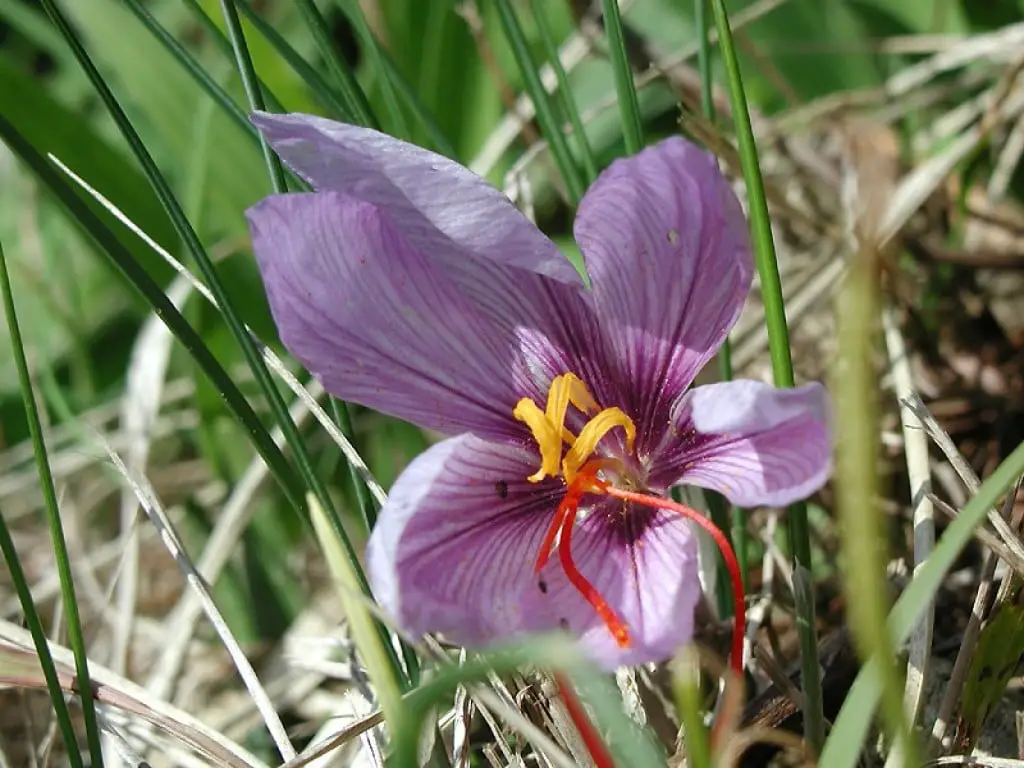
- Common Name: Saffron
- Scientific Name: Crocus sativus
- Type: Perennial
- Water: Low
- Soil PH: Acid, Alkaline, Neutral
- Flower Color: Purple
- Special Characteristics: Showy
- Hardiness Zone(s): 5-9
- Height At Maturity: 4-6″
- Sun: Full Sun
- Sub Type: Beds & Borders
Salvia Splendens
Salvia Splendens, Salvia splendens flower is a species of flowering plant in the Lamiaceae family.
Salvia splendens is more commonly known as Scarlet sage It’s native to Mexico and Guatemala.
Salvia can grow tall on stems that are thickly covered with small leaves.
It’s a perennial plant that grows at high altitudes in Brazil.
In the wild, it grows up to 4 feet tall.
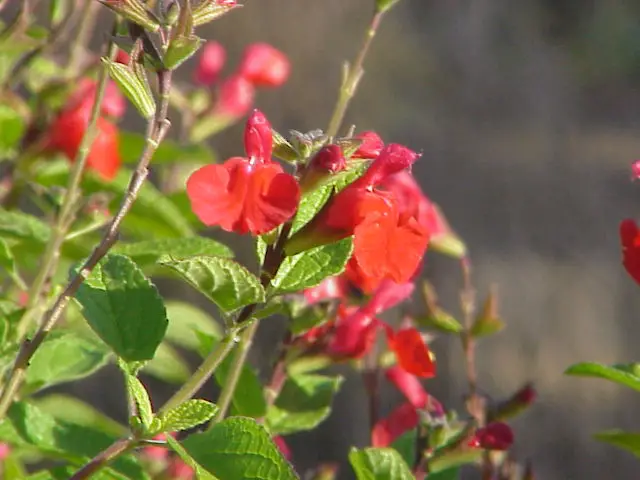
- Common Name: Scarlet Sage
- Scientific Name: Salvia splendens
- Type: Perennial
- Water: Moderate moisture
- Soil PH: 6.0 to 7.5
- Flower Color: Red
- Special Characteristics: Attracts birds and butterflies, container, deer resistant, easy-to-grow
- Hardiness Zone(s): 10 to 11
- Height At Maturity: 24″ to 48″
- Sun: Full Sun, Partial Shade
- Sub Type: Groundcover
Sand Dollar Cactus
The Sand Dollar Cactus is a name given to the cacti in the genus Astrophytum that produces a unique flower that resembles a Sand dollar shell.
The body of the cactus itself is wide with five to eight grooves along the shell.
The Sand dollar cactus tends to flower between May and June but depends on where it’s being cultivated.
The Sand Desert Cactus grows well in a warm climate that has a significant amount of sunlight.
This type of cactus also goes by the names sea urchin cactus, star cactus, and star peyote.
The flowers of the sand dollar cactus are yellow with red bases and the outer parts are very woolly.
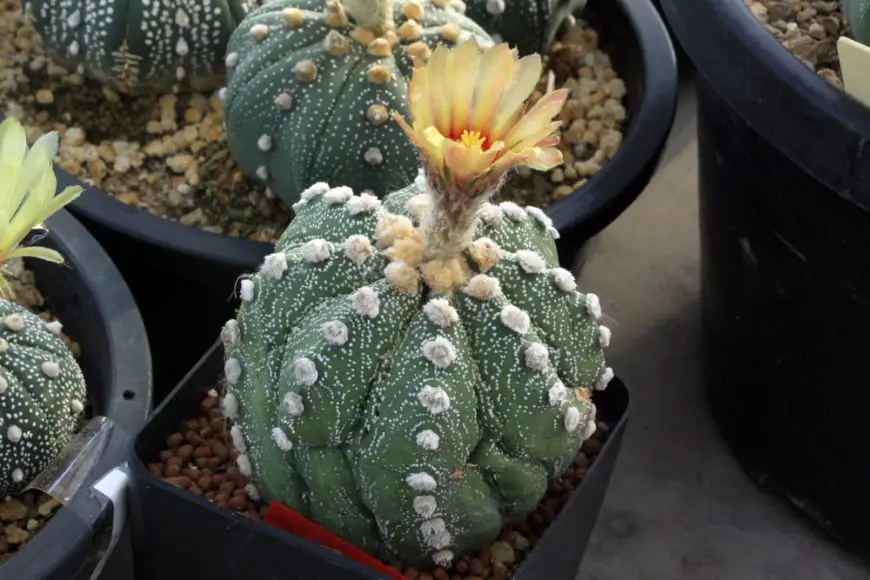
- Common Name: Sand Dollar Cactus
- Scientific Name: Astrophytum asterias
- Type: Cactus/Succulent
- Water: Dry
- Soil PH: 6.1 to 7.8
- Flower Color: Orange, White
- Special Characteristics: Showy flowers, container
- Hardiness Zone(s): 10
- Height At Maturity: 1-6″
- Sun: Full Sun, Partial Shade
- Sub Type: Houseplant
Sand Phlox
Sand Phlox, Sand Phlox flower – Sand Phlox is a subspecies of the phlox genus found in North America.
Sand phlox grows in areas that are generally sandy or have sandy soils, hence its name.
They can be found growing in the Great Sand Dunes National Park and Preserve of Colorado.
It is a flowering ground cover that spreads out across the sand, and it blooms in mid to late spring.
It grows a dense mat of blue or purple flowers.
One of the most beautiful of all the S name flowers.
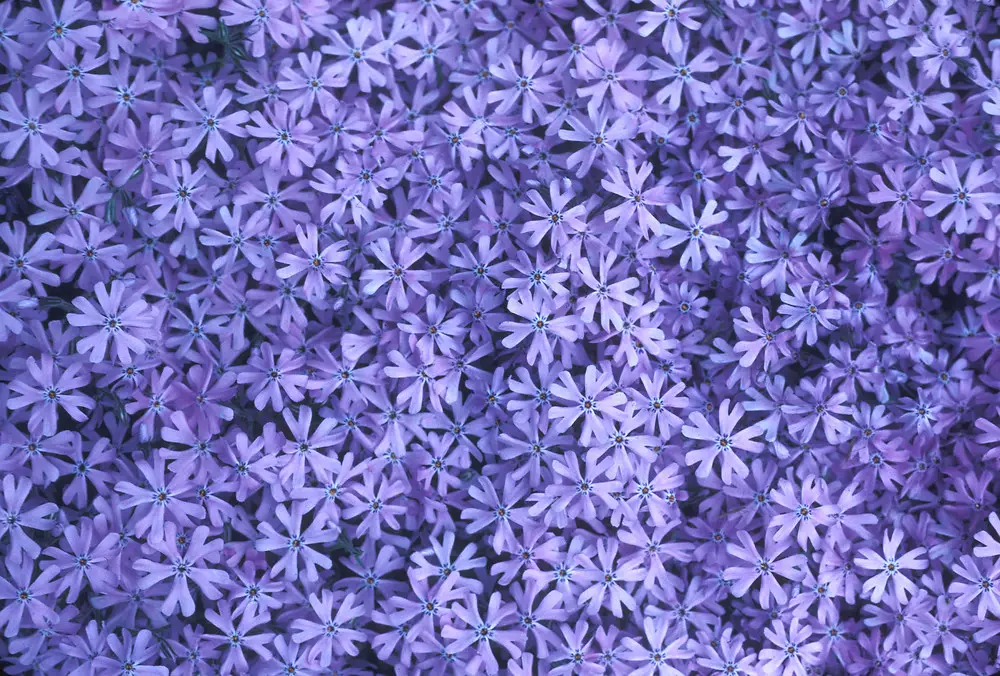
- Common Name: Sand phlox
- Scientific Name: Phlox bifida
- Type: Perennial
- Water: Dry to medium
- Soil PH: 5 to 6
- Flower Color: Purple
- Special Characteristics: Attracts butterflies, deer-resistant, fragrant, showy flowers
- Hardiness Zone(s): 4 to 8
- Height At Maturity: 3-6″
- Sun: Full sun to part shade
- Sub Type: Groundcover
Scarlet Hedgehog Cactus
The Scarlet Hedgehog cactus is a member of the Echinocereus genus. The Scarlet Hedgehog cactus has showy pink flowers in summer.
It can also be kept as a houseplant and is fairly easy to care for.
They like well-drained soils, full sun exposure, and generally have moderate water needs.
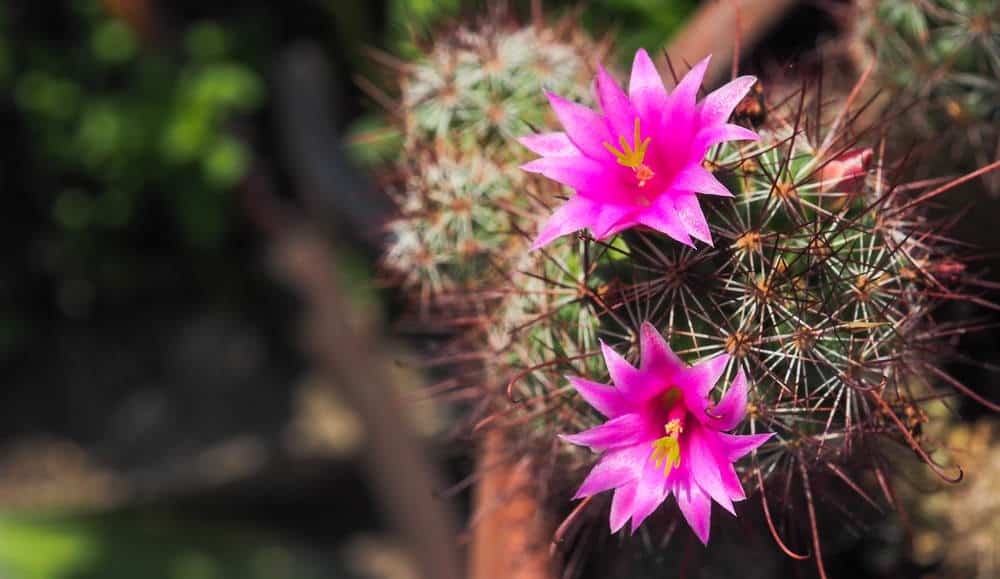
- Common Name: Scarlet Hedgehog Cactus
- Scientific Name: Echinocereus Coccineus
- Type: Cactus/Succulent
- Water: Dry
- Soil PH: 6.1 to 7.8
- Flower Color: Red
- Special Characteristics: Container, Tolerates Drought, Showy Flowers
- Hardiness Zone(s): 8 to 11
- Height At Maturity: 6″ to 12″
- Sun: Full Sun
- Sub Type: Evergreen
Scarlet Strawberry
The Scarlet Strawberry is a species of flowering plant in the family Rosaceae. It is native to China but widely cultivated elsewhere for its edible fruit.
It is is one of two species of wild strawberry that were hybridized to create the modern domesticated garden strawberry.
Scarlet strawberry fruit taste can range from sweet to tart, depending on the cultivar, and are brightly colored when mature.
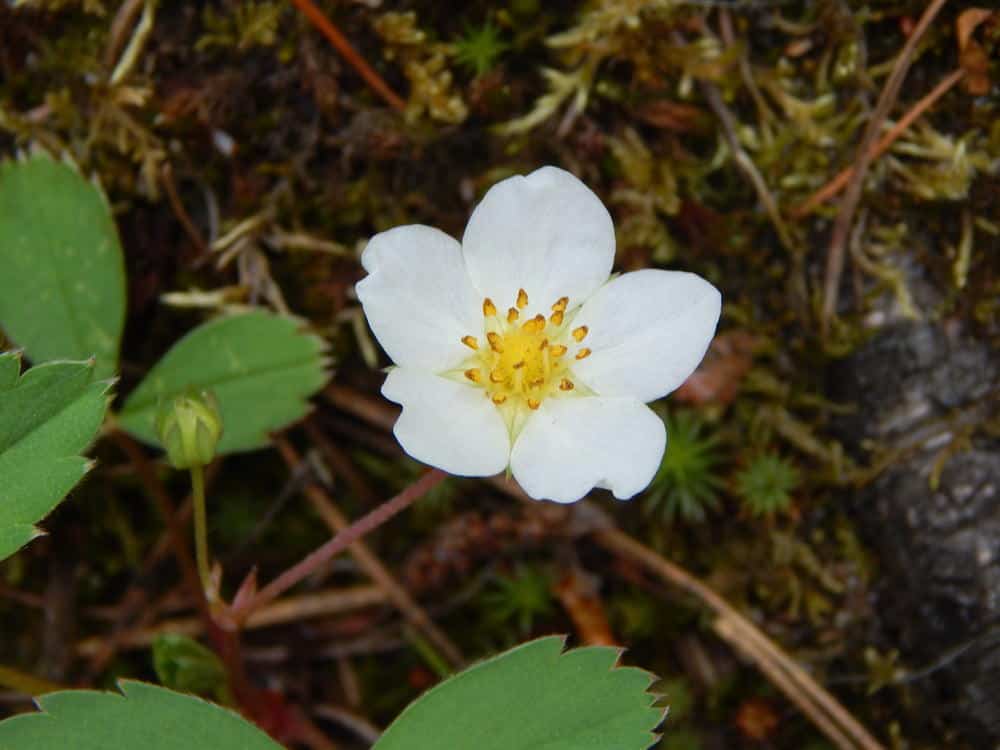
- Common Name: Scarlet strawberry
- Scientific Name: Fragaria virginiana
- Type: Perennial
- Water: Medium
- Soil PH: 6.0 to 6.5
- Flower Color: White
- Special Characteristics: Attracts birds, deer-resistant, showy flowers, edible
- Hardiness Zone(s): 5 to 9
- Height At Maturity: 4-7”
- Sun: Full sun to part shade
- Sub Type: Groundcover
Saponaria
The Saponaria flower is a species of pink, purple or white flowers. Saponaria is a plant genus in the family Caryophyllaceae.
Saponaria has been used as herbal medicine, and it contains saponins which have been shown to have medicinal properties.
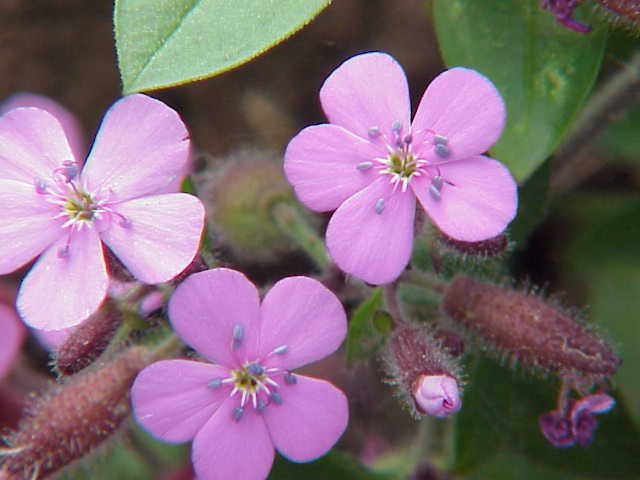
- Common Name: Rock Soapwort
- Scientific Name: Saponaria Ocymoides
- Type: Perennial
- Water: Low, Average
- Soil PH: Alkaline, Neutral
- Flower Color: Bright Pink
- Special Characteristics: showy flowers, semi-evergreen deer resistant
- Hardiness Zone(s): 2 to 9
- Height At Maturity: 6-9”
- Sun: Full sun
- Sub Type: Groundcover
Scabiosa
Scabiosa columbaria, also known as the Scabious Scabiosa or Scabious/Scabiosa Columbaria, is a species of flowering plant in the family Caprifoliaceae.
The Scabious Scabiosa grows to around 40 inches tall and flowers from June through September.
It flowers in light lavender or blue.
Scabiosa flowers are rich in nectar and attract insects including butterflies and moths.
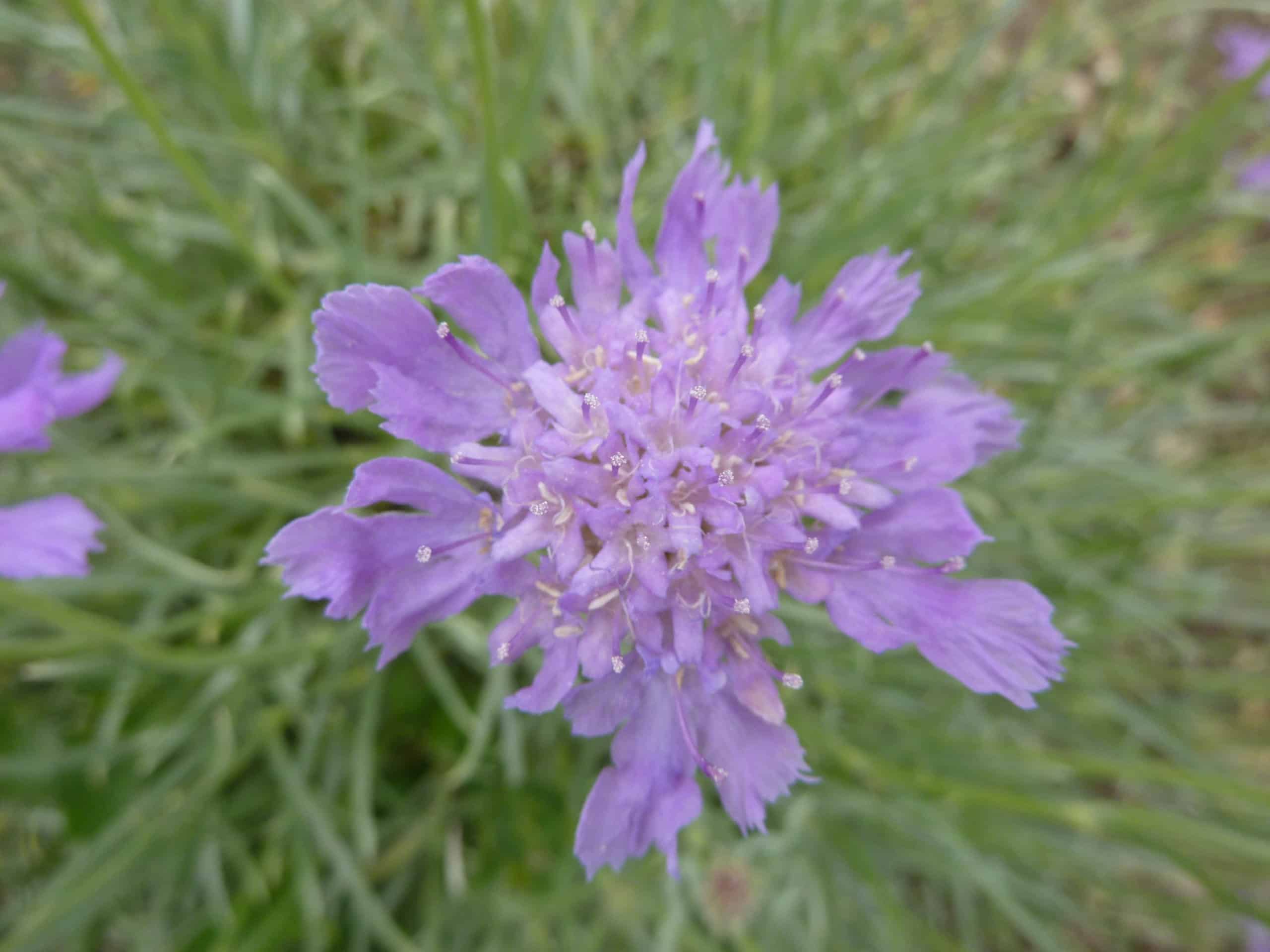
- Common Name: Butterfly Blue
- Scientific Name: Scabiosa Columbaria
- Type: Perennial
- Water: Low, Average
- Soil PH: Acid, Alkaline, Neutral
- Flower Color: Lavender-Blue
- Special Characteristics: attracts butterflies, deer resistant, drought-resistant
- Hardiness Zone(s): 3 to 9
- Height At Maturity: 1-2′
- Sun: Full sun
- Sub Type: Beds & Borders
Scaevola
The Scaevola is a genus of flowering plants which belongs to the Goodeniaceae family.
Scaevolas are also known as fan flowers because of their brush-shaped flower clusters.
Scaevolas can be planted in borders, patios, or even pots to add color and beauty to your home landscaping.
It is hardy enough to grow all year round as a house plant. Although, Scaevolas typically prefer full sun and well-drained soil.
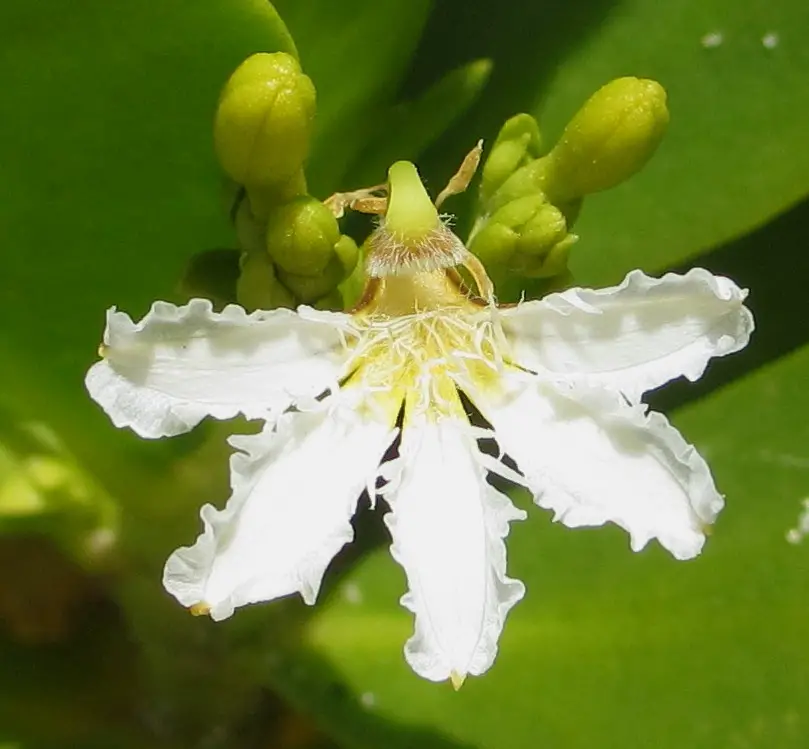
- Common Name: Fan Flower
- Scientific Name: Scaevola aemula
- Type: Annual
- Water: Medium
- Flower Color: Lavender-Blue
- Special Characteristics: showy flowers
- Hardiness Zone(s): 10 to 11
- Height At Maturity: .75-1.5′
- Sun: Full sun – part shade
- Sub Type: Beds & Borders
Scarlet Buckeye
Red Buckeye blossoms bright red flowers.
It can be grown in all soil textures and is almost pest-free. Its flowers, which last several weeks during the spring, attract hummingbirds and butterflies.
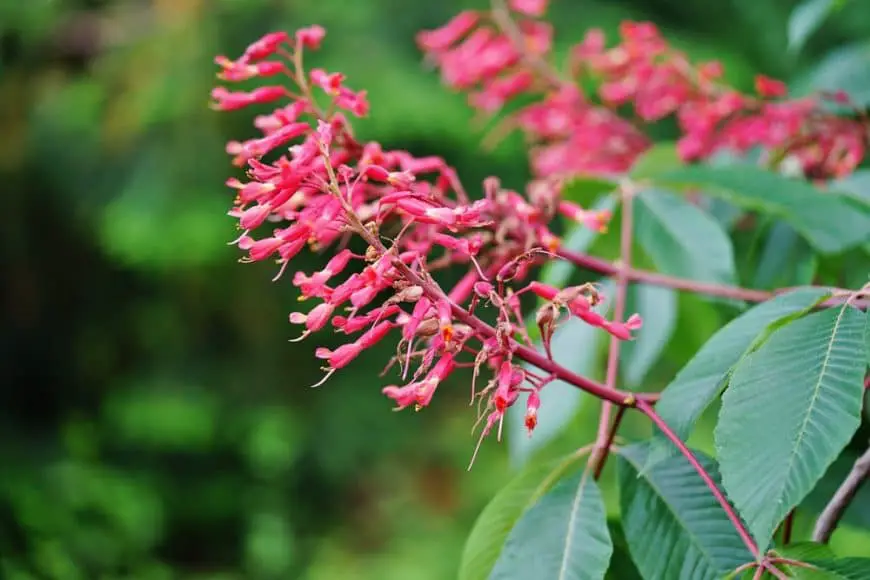
- Common Name: Scarlet Buckeye
- Scientific Name: Aesculus Pavia
- Type: Shrub
- Water: Moderate
- Soil PH: 6.1 to 7.5
- Flower Color: Pink, Red
- Special Characteristics: Attracts birds and butterflies, Showy Flowers, Poisonous
- Hardiness Zone(s): 4 to 8
- Height At Maturity: 144″ to 180″
- Sun: Full Sun, Partial Shade
- Sub Type: Deciduous
Scented Geranium
The Scented Geranium has been cultivated for centuries because of its attractive smell and taste.
The Scented Geranium, also known as a ‘Pelargonium’ is a flower that comes from South Africa.
Many Scented Geranium plants contain high concentrations of essential oils. This is the reason why Scented Geraniums are often used to make tea, desserts, or as a flavoring for toothpaste or mouthwash
Though they are perennials, they are treated as annuals in most of the western world.
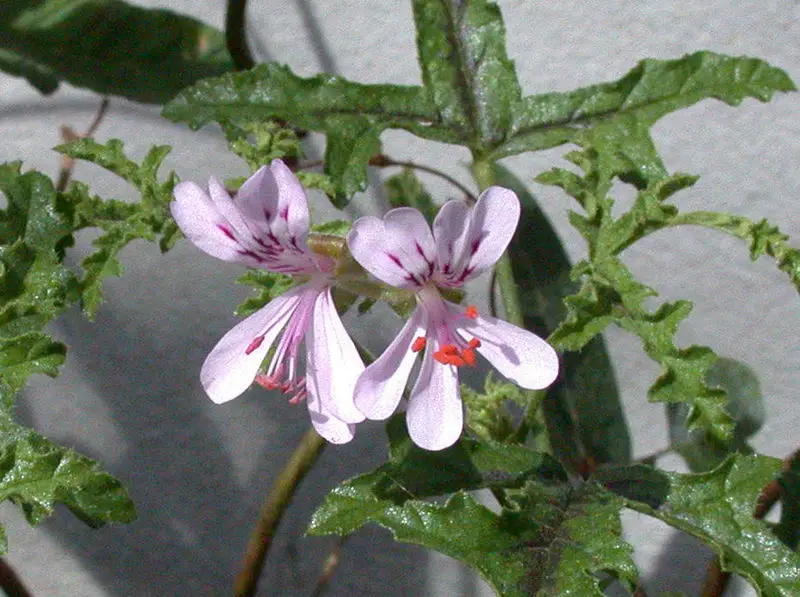
- Common Name: Scented Geranium (Grace Thomas)
- Scientific Name: Pelargonium
- Type: Perennial
- Water: Average
- Soil PH: Alkaline, Neutral
- Flower Color: Pink
- Special Characteristics: showy flowers, fragrant flowers, drought-resistant
- Hardiness Zone(s): 9 to 11
- Height At Maturity: 1-2′
- Sun: Full sun, Partial sun
- Sub Type: Beds & Borders, Containers
Scilla
Scilla grows in woodlands, subalpine meadows, and seashores.
They are bulb-forming perennials.
There are roughly 90 species of scilla plants most of which grow in Europe and Africa.
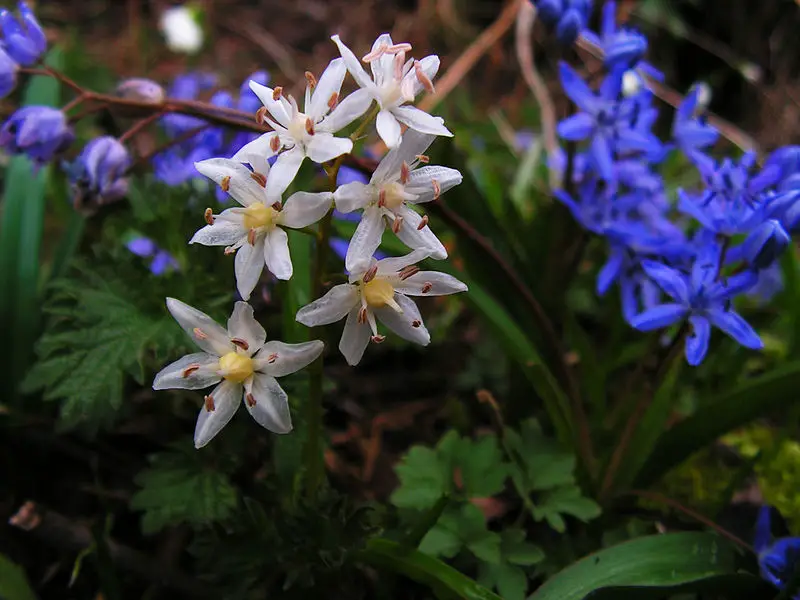
- Common Name: Siberian Squill
- Scientific Name: Scilla Siberia
- Type: Perennial Bulbs
- Water: Average
- Soil PH: Acid, Alkaline, Neutral
- Flower Color: White
- Special Characteristics: showy flowers, deer-resistant, rabbit-resistant, drought-resistant
- Hardiness Zone(s): 2 to 8
- Height At Maturity: 3-6″
- Sun: Full sun, Partial sun
- Sub Type: Beds & Borders, Containers
Sea Holly
The Sea Holly flower is an unusual flower that blooms in the summer.
These are annual and perennial herbs with hairless and usually spiny leaves.
Sea Holly flowers have thistle-like, silvery or blue tinted flower heads.

- Common Name: Sea holly
- Scientific Name: Eryngium planum
- Type: Perennial
- Water: Dry
- Soil PH: 5.8 – 6.8
- Flower Color: Steel blue
- Special Characteristics: Showy flowers, cut flowers, easy-to-grow
- Hardiness Zone(s): 5 to 9
- Height At Maturity: 24-36′
- Sun: Full sun
- Sub Type: Groundcover
Sea Thrift
Sea thrift (Armeria maritima) is a perennial flower that grows in the wild on the European and Asian coasts of the North Sea as well as on some other coasts around the world.
The plant was introduced to North America around 1877, after being first brought from Europe for its ornamental value.
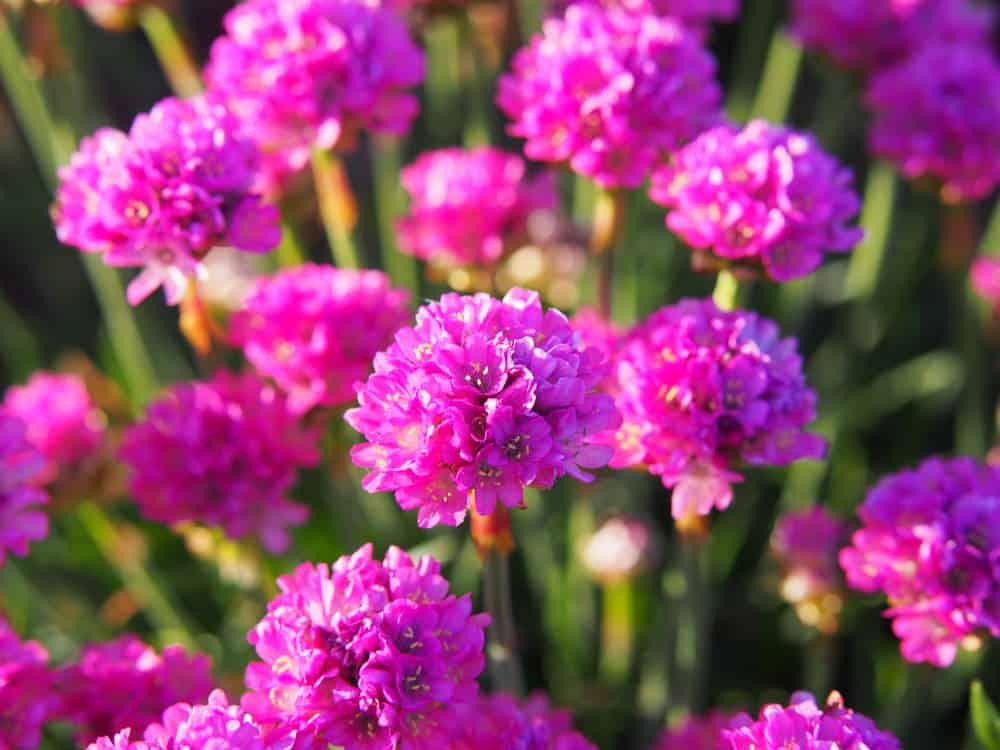
- Common Name: Sea thrift
- Scientific Name: Armeria maritima
- Type: Perennial
- Water: Dry
- Soil PH: 5.5-7.5
- Flower Color: Pink to white
- Special Characteristics: Showy flowers
- Hardiness Zone(s): 4 to 8
- Height At Maturity: 6-12′
- Sun: Full sun
- Sub Type: Groundcover
Sedum
Sedum (or Stonecrops) is a genus of flowering plants in the family Crassulaceae.
Sedums are native to Europe, Asia, and Africa, but are grown around the world as houseplants and garden plants.
Sedums are slow-growing herbaceous perennials that grow in informal clumps or mats, with fleshy leaves.
Sedums have a tendency to survive for a very long time in unfavorable conditions.
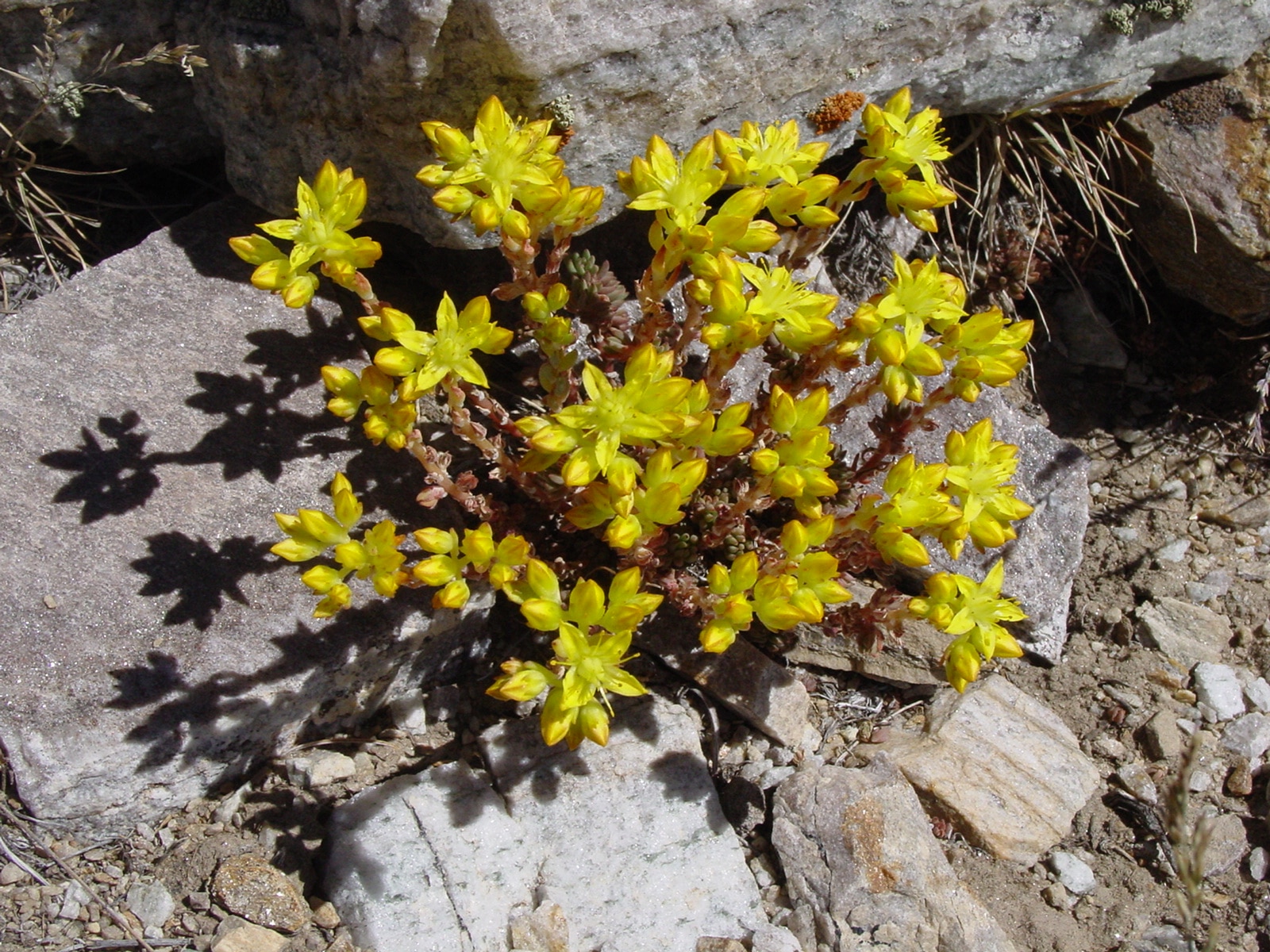
Shasta Daisy
Shasta daisy is a flower that belongs to the genus Leucanthemum in the Asteraceae family.
Shastas are familiar flowers with white petals and yellow centers.
They do have a distinct odor that some find unpleasant.
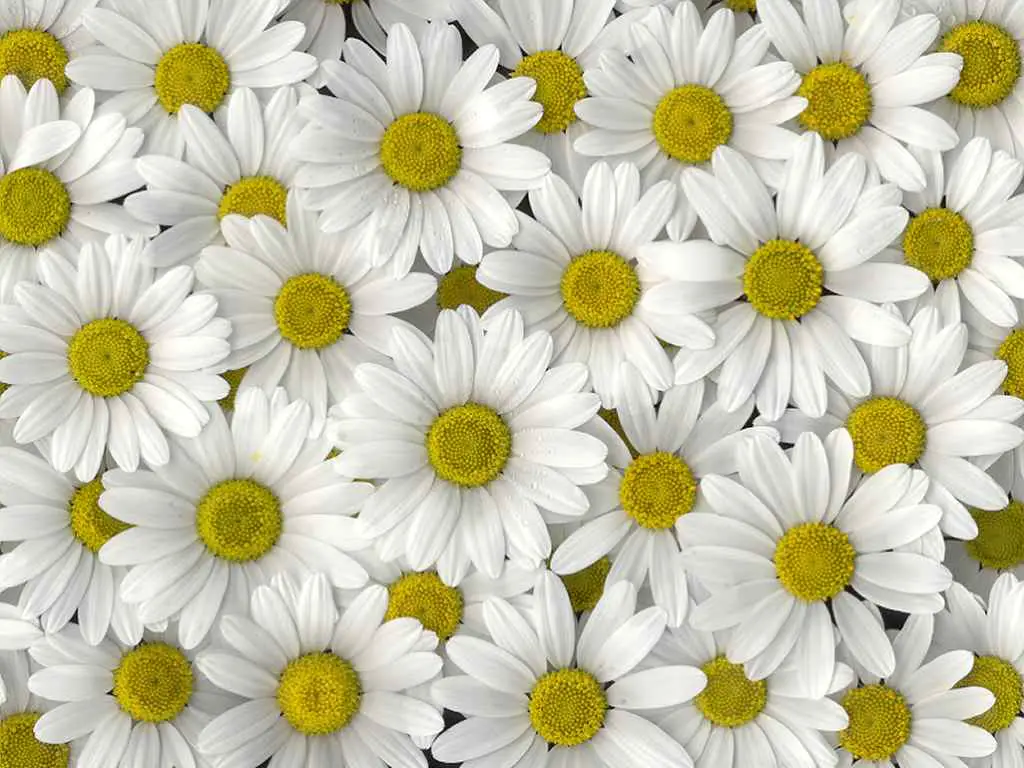
- Common Name: Shasta Daisy
- Scientific Name: Leucanthemum × Superbum
- Type: Perennial
- Water: Dry to medium
- Soil PH: 6-8
- Flower Color: White rays with yellow center
- Special Characteristics: Attracts birds and butterflies, Container
- Hardiness Zone(s): 5 to 9
- Height At Maturity: 24″-36″
- Sun: Full Sun
- Sub Type: Groundcover
Shooting Star Flower
Shooting Star Flowers are most commonly found on grasslands, meadows and hillsides.
This perennial flower blooms between March and May depending on the particular Shooting Star Flower species’ range.
Shooting Star Flowers have five light violet petals with pointed tips that look like they’re shooting off in different directions.
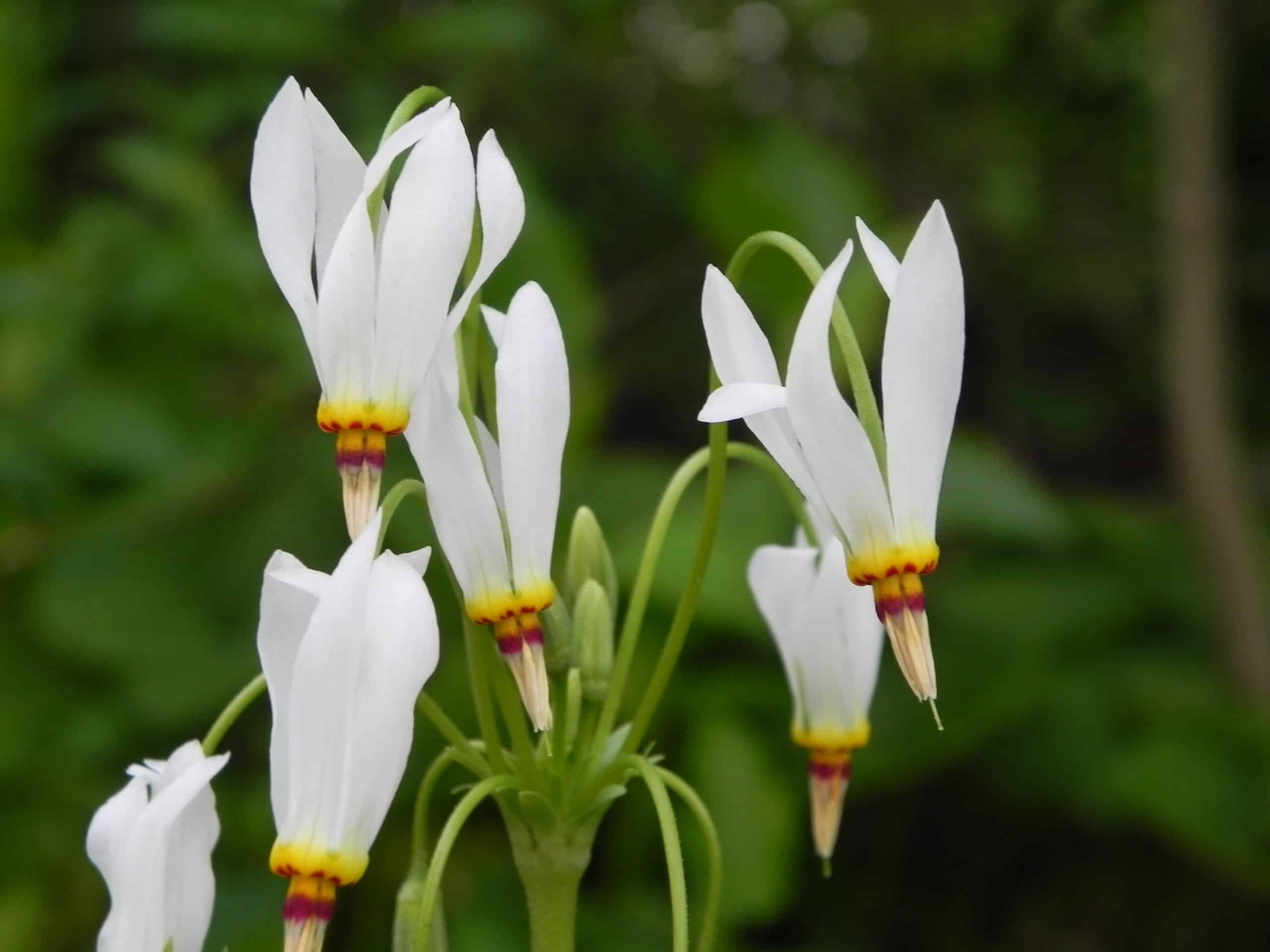
- Common Name: Shooting Star Flower
- Scientific Name: Dodecatheon meadia
- Type: Perennial
- Water: Medium
- Soil PH: 6-7
- Flower Color: White, pink, purple
- Special Characteristics: Easy-to-grow, Container, Attracts birds, Cut flowers, Fragrant
- Hardiness Zone(s): 4 to 8
- Height At Maturity: 9″-18″
- Sun: Full Shade
- Sub Type: Groundcover
Silene
The Silene flower is a flowering plant in the family Caryophyllaceae that come from woodlands worldwide because they are shade-loving plants.
Most Silene species grow as perennial plants. They produce small, white, pink, or purplish petals.
They are often referred to as “catch flies” due to their distinct shaped flowers.
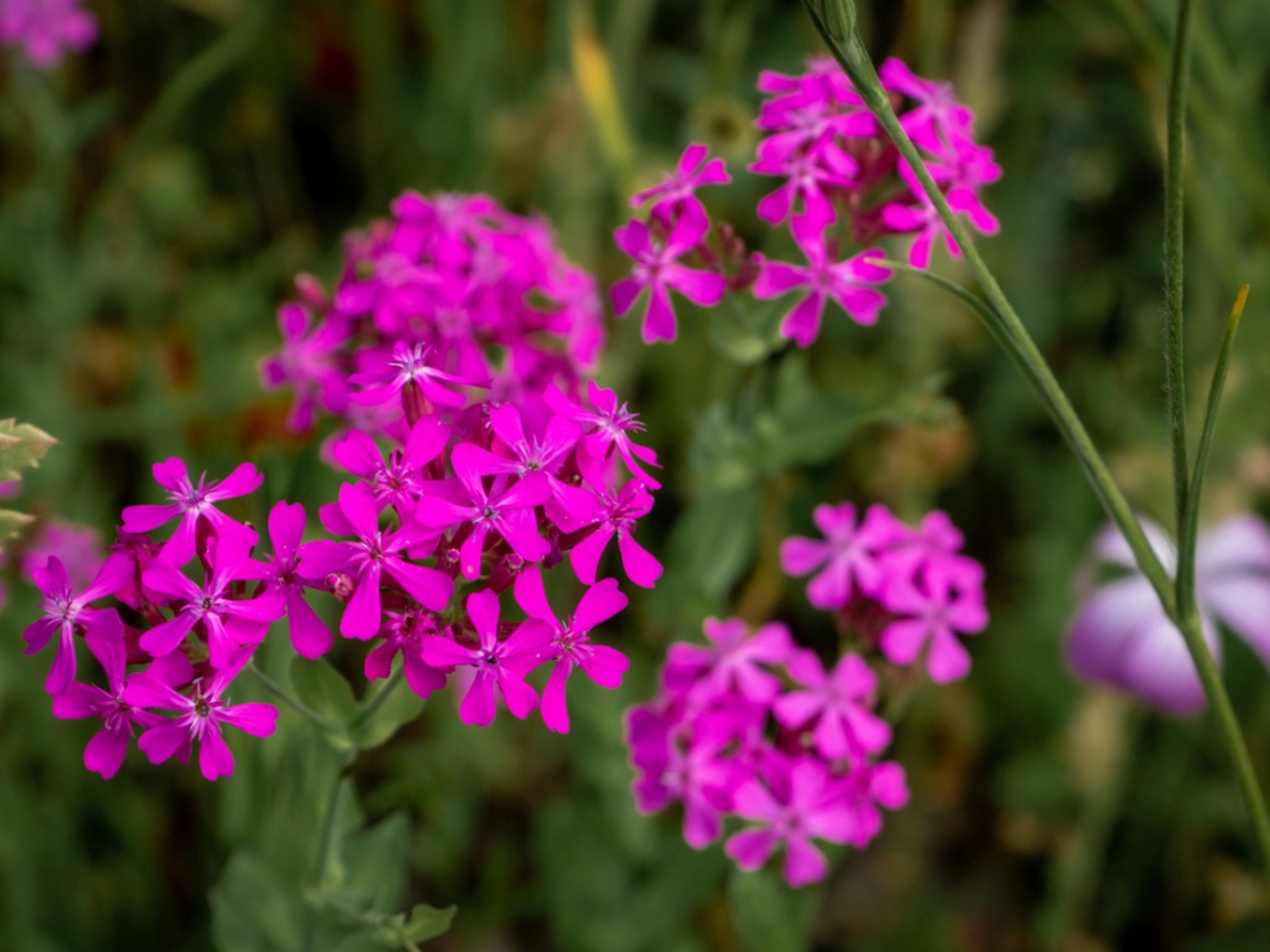
Showy Milkweed
Showy Milkweed Showy milkweeds are a group of plants in the genus “Asclepias” that come from North and South America.
Showy milkweed grows in a variety of habitats, from dry fields to moist woods.
Many people plant Showy milkweeds as a way to attract monarch butterflies because they lay their eggs on Showy Milkweed plants, and those eggs turn into caterpillars that feed on Showy Milkweed leaves.
The flowers grow loosely in clusters toward the top of the stems. T
hey are rose-purple in color but will transform into a yellow as the plant ages.
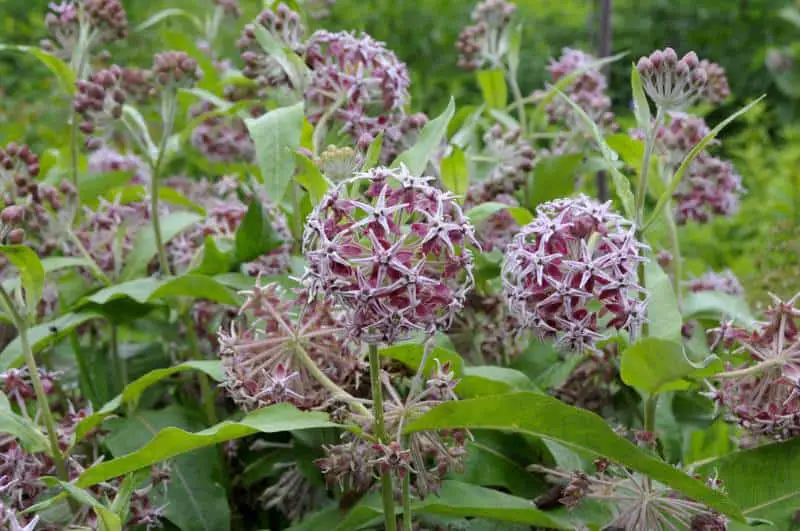
- Common Name: Showy milkweed
- Scientific Name: Asclepias speciosa
- Type: Perennial
- Water: Dry to medium
- Soil PH: 5.8 – 7.2
- Flower Color: Purplish rose
- Special Characteristics: Attracts hummingbirds and butterflies, deer-resistant, showy flowers, easy-to-grow
- Hardiness Zone(s): 3 to 9
- Height At Maturity: 6-36″
- Sun: Full sun
- Sub Type: Groundcover
Shrub Rose
Shrub Roses can be found growing naturally in the wild as well as in gardens and landscaping. They are easy-growing members of the rose family and are easier to maintain when compared to the classic rose.
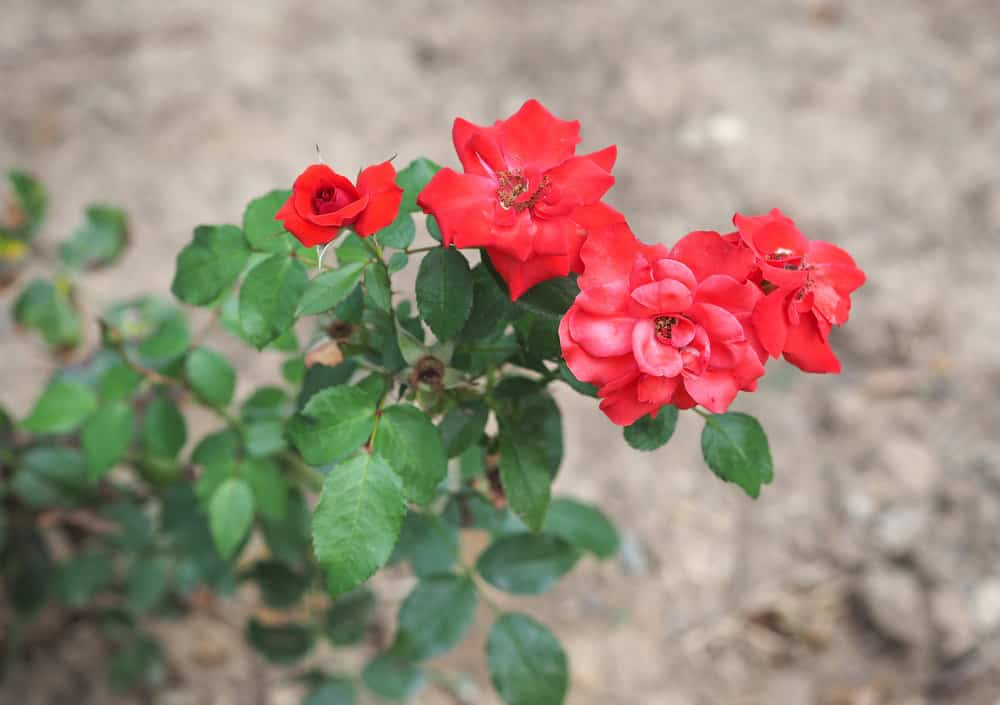
- Common Name: Shrub Rose
- Scientific Name: Rosa
- Type: Shrub
- Water: Moderate
- Soil PH: 6.5
- Flower Color: Red, Pink, Orange, Yellow, White, Purple
- Special Characteristics: Container, attracts birds and butterflies, Showy Flowers, Fragrant, Cut Flowers
- Hardiness Zone(s): 3 to 10
- Height At Maturity: 12″ to 240″
- Sun: Full Sun to Part Shade
Silky Wormwood
Silky wormwood is a dwarf evergreen shrub in the sunflower family that has been used for centuries as a medicinal aid.
While it is native to the Southwest United States and Mexico, it has been introduced in many other areas.
It has a low potential for becoming an invasive species, so can be planted with minimal danger of taking over the surrounding area.
It is also extremely drought tolerant and best grown in poor to moderately fertile, dry, well-drained soils in full sun.
In the summer it produces tiny yellow flowers that appear to be nodding.
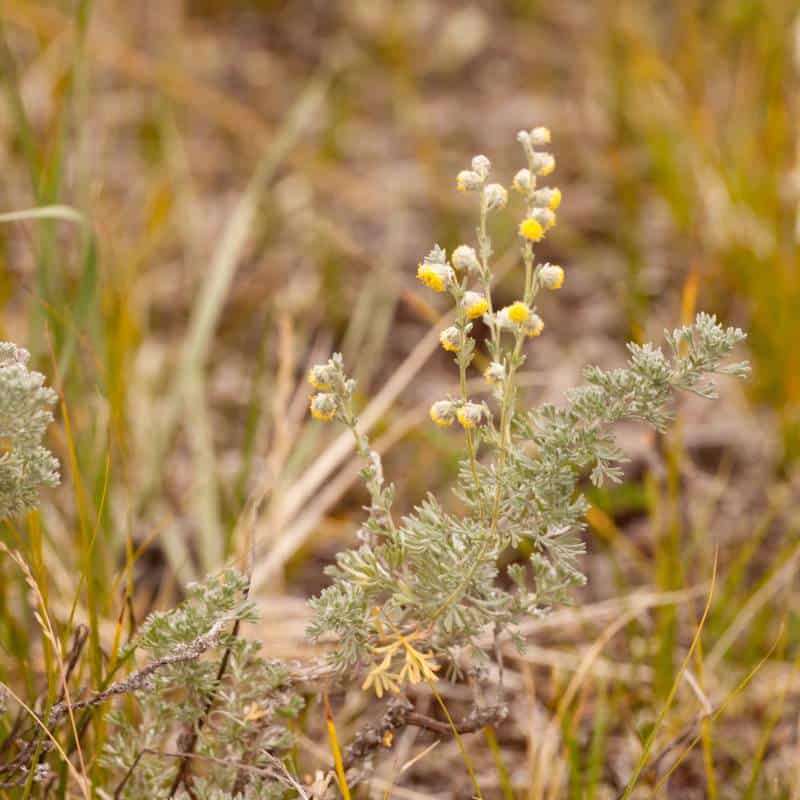
- Common Name: Silky wormwood
- Scientific Name: Artemisia frigida
- Type: Perennial
- Water: Dry
- Soil PH: 7.5-7.7
- Flower Color: Yellow
- Special Characteristics: Tolerates rabbit, deer-resistant, fragrant
- Hardiness Zone(s): 3 to 10
- Height At Maturity: 3-18″
- Sun: Full sun
- Sub Type: Groundcover
Smoke Tree
Smoke Tree is a flowering seasonally deciduous tree that grows in the southwestern United States and northwestern Mexico.
Smoke Tree leaves produce an abundance of small purple flowers that can be used to create Smoke oil, which is often used for medicinal purposes.
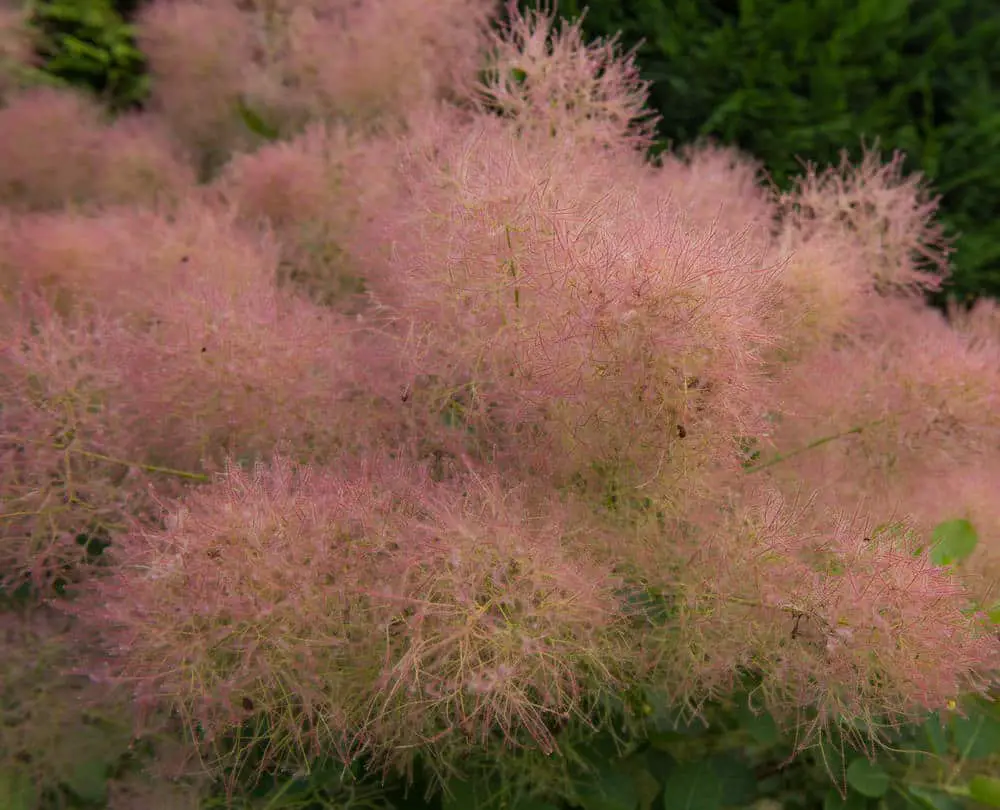
- Common Name: Smoke Tree
- Scientific Name: Cotinus Coggygria
- Type: Shrub
- Water: Moderate
- Soil PH: 6.1 to 7.8
- Special Characteristics: Easy to grow, Tolerate deer, Tolerate Drought
- Hardiness Zone(s): 5 to 8
- Height At Maturity: 120″ to 180″
- Sun: Full Sun
- Sub Type: Deciduous
Snow-in-Summer
Snow-in-Summer flower is a flowering plant in the genus “Hypericum” and section “Ascyreia”.
Snow-in-Summer flowers grow on erect ~6 cm tall stems that bear bloom white flowers between June and August in the Northern Hemisphere.
This herbaceous flowering plant is a member of the carnation family. Snow-in-Summer is usually grown as ground cover. It thrives in full sun.
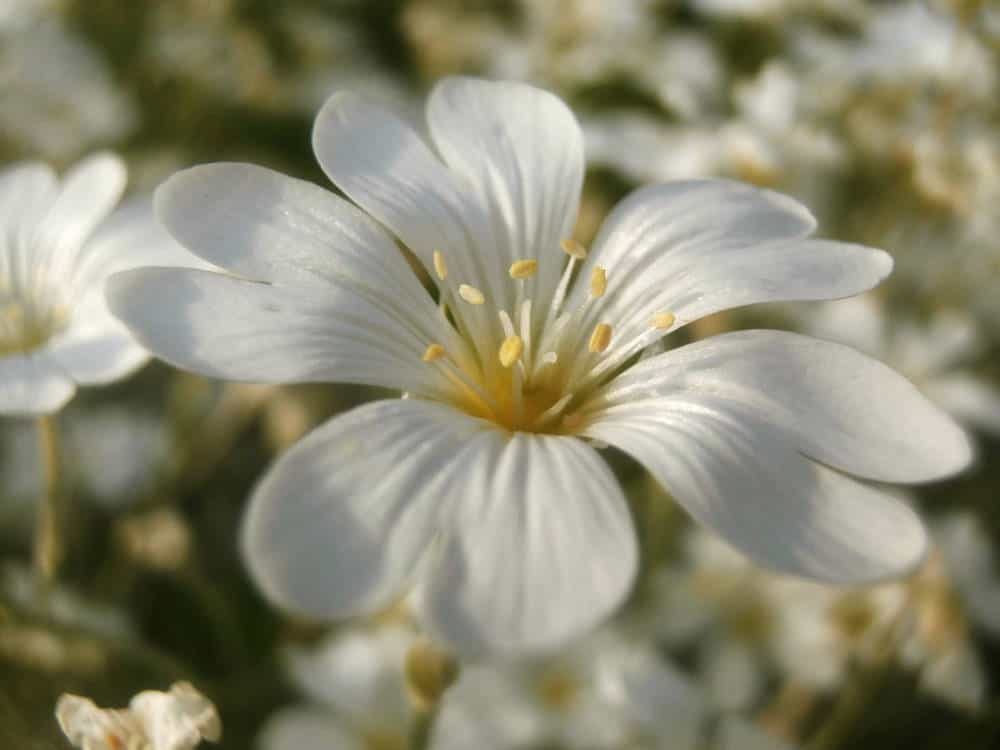
- Common Name: Snow-in-summer
- Scientific Name: Cerastium tomentosum
- Type: Perennial
- Water: Dry
- Soil PH: 6 to 7
- Flower Color: White
- Special Characteristics: Deer-resistant, showy flowers
- Hardiness Zone(s): 3 to 7
- Height At Maturity: 6-12′
- Sun: Full sun
- Sub Type: Groundcover
Snowdrop Windflower
A Snowdrop Windflower flower is a type of Snowdrop flower that grows throughout North America.
It produces lily-like flowers that are fragile, during the early to mid-spring atop radiant dense, green foliage.
Snowdrops Windflowers can be found growing on moist soils in woodlands, meadows and along the edges of ponds.
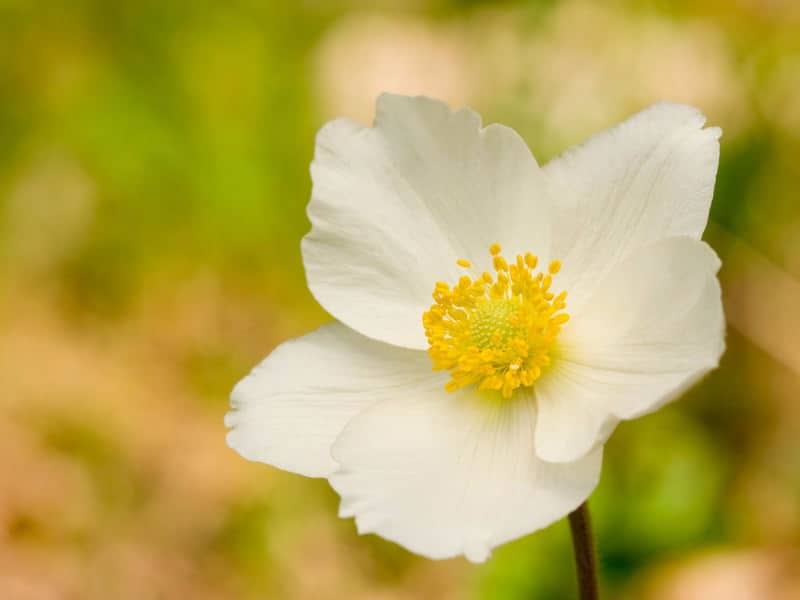
- Common Name: Snowdrop Windflower
- Scientific Name: Anemone sylvestris
- Type: Perennial
- Water: Needs moderate moisture
- Soil PH: 5.5-6.8
- Flower Color: White with yellow stamens
- Special Characteristics: Deer-resistant, showy flowers, cut flowers, fragrant, easy to grow
- Hardiness Zone(s): 4 to 8
- Height At Maturity: 12-18”
- Sun: Part shade
- Sub Type: Groundcover
Solanum
he Solanum flower is also known as the Nightshade flower. They bloom in colors from white to lavender to deep purple.
Solanum flowers grow on vines that can reach up to and beyond 20 feet long.
Solanum comprises a variety of flowering plants like potato, tomato, and eggplant.
But, there’s also Solanum Jasminum Album which is a variety of Jasmine flower.
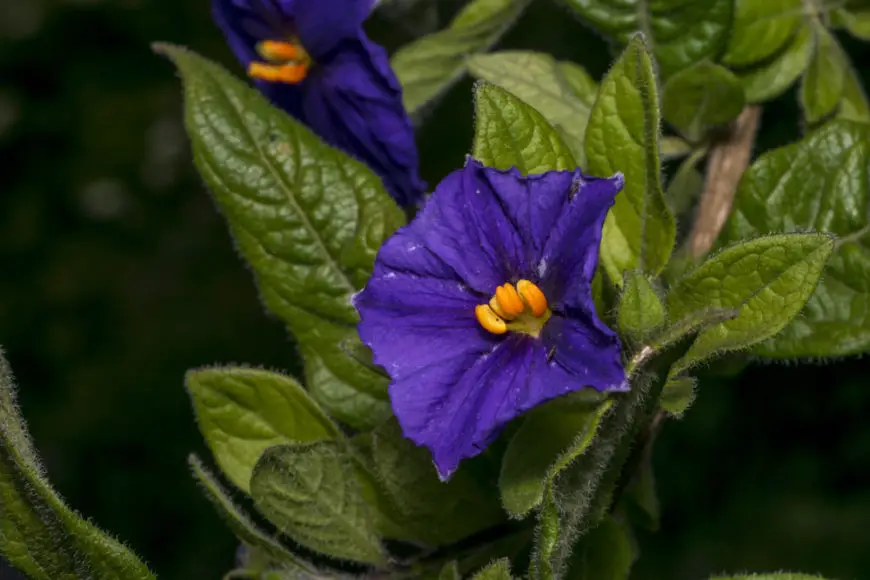
- Common Name: Solanum
- Scientific Name: Solanum
- Type: Shrub
- Water: Moderate
- Soil PH: 6.5 to 7.5
- Flower Color: Violet, White, Lavander
- Special Characteristics: Showy flowers, Attracts birds and butterflies
- Hardiness Zone(s): 8 to 10
- Height At Maturity: 60″ to 96″
- Sun: Full Sun
- Sub Type: Deciduous
Solomon’s Seal
The Solomon’s seal flower (Polygonatum odoratum) is a plant that can be found across most of North America.
The Solomon’s seal flower is a perennial plant, meaning it grows year after year rather than dying off in the winter.
The flowers are usually an inch across but ranges to 2 inches. Solomon’s seal blooms between May and June depending on the location and climate. Solomon’s seal creates white or piny flowers which contrast nicely with their green leaves.
Solomon’s seal has a nice fragrance so many people enjoy planting it for this reason.
The majority of Solomon’s seal plants are between 1 and 2 feet tall, they take several years to get there.
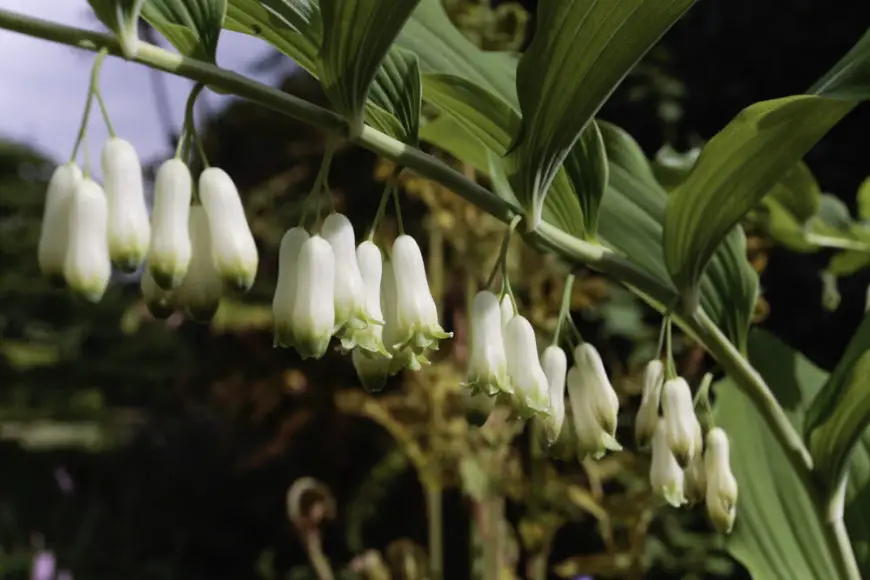
- Common Name: Solomon’s seal
- Scientific Name: Polygonatum biflorum
- Type: Perennial
- Water: Medium to wet
- Soil PH: 6-7
- Flower Color: Greenish white
- Special Characteristics: Cut flowers, Container, Fragrant, Easy-to-grow
- Hardiness Zone(s): 3 to 8
- Height At Maturity: 12″-36″
- Sun: Full Shade
- Sub Type: Groundcover
Sorrel
Sorrel flowers are bright and edible and grow in the springtime in many gardens or wildflower meadows.
Sorrels are often used in cooking to add sourness to dishes, although most people neglect to use them because of this taste.
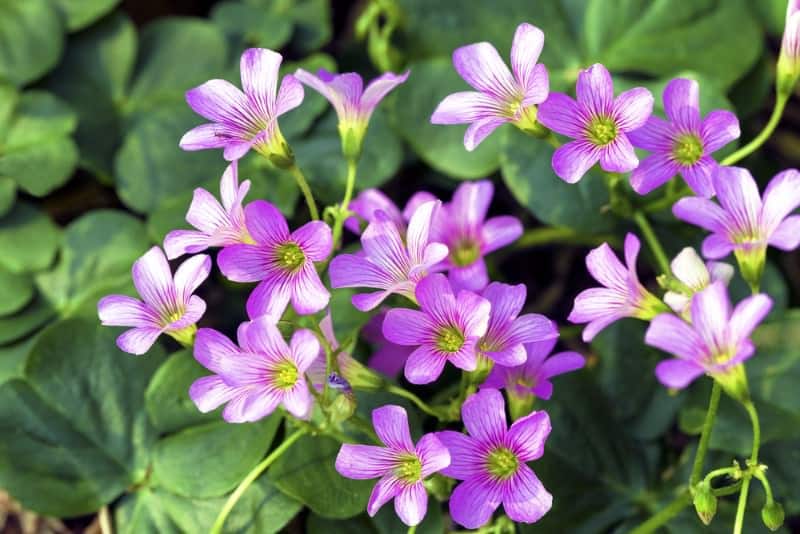
- Common Name: Sorrel
- Scientific Name: Oxalis articulata subsp. rubra
- Type: Perennial
- Water: Medium
- Soil PH: 6.6 to 9.0
- Flower Color: Mauve pink
- Special Characteristics: Showy flowers
- Hardiness Zone(s): 7 to 10
- Height At Maturity: 3-9″
- Sun: Full sun to part shade
- Sub Type: Groundcover
Syringa
Syringa is a genus of shrubs and small trees with fragrant, tubular blooms that epitomize spring.
When they are not in bloom, they tend to fade into the background.
They may be grown as specimens or in groups in the lawn or shrub border; additionally, they make for excellent privacy hedges.
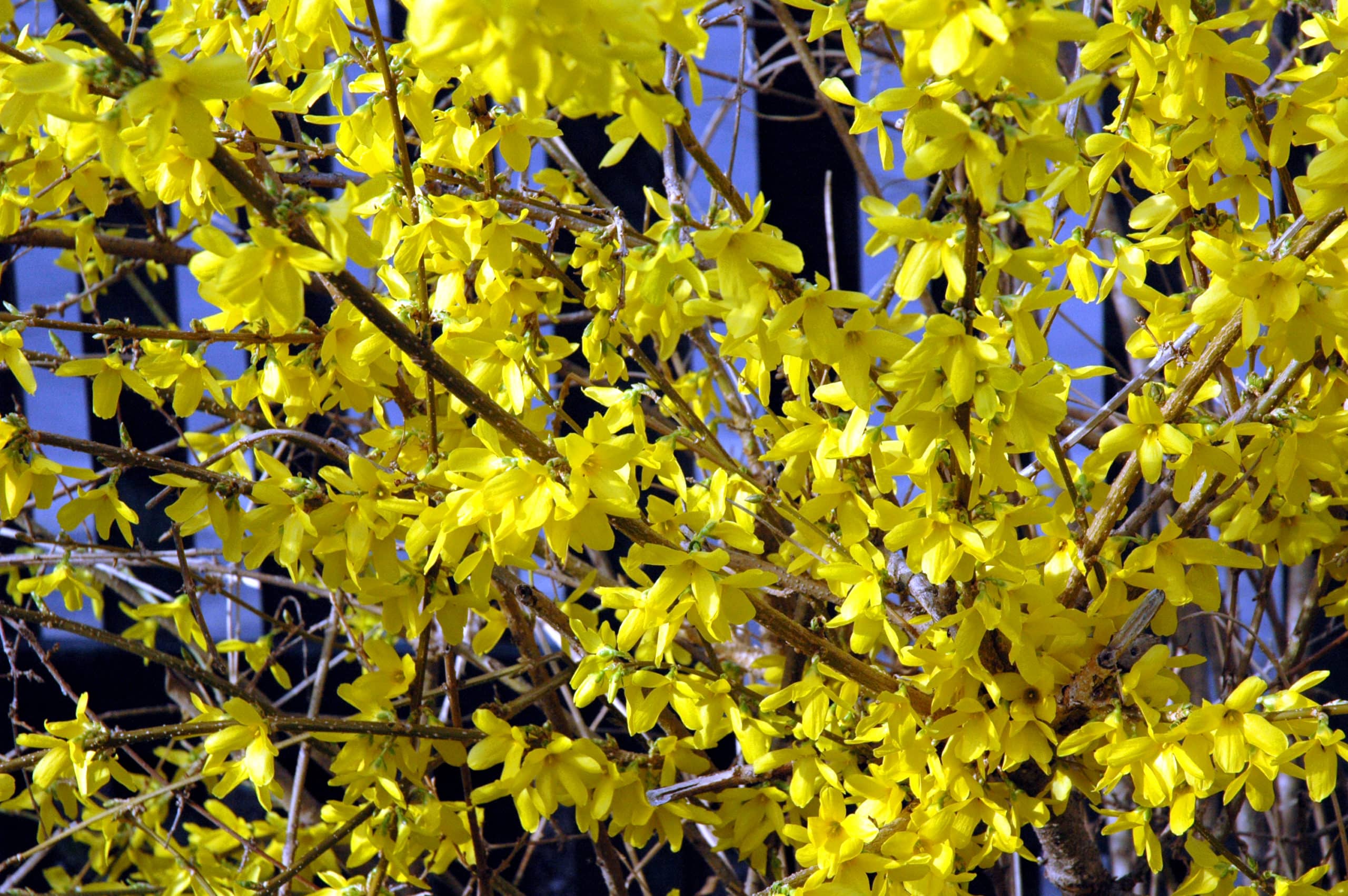
Scarlet Rose Mallow
The leaves of this 4-7 ft. rose mallow are shiny and of a deep-scarlet color. They are over 6 inches in width.
A large plant with big, showy, crimson flowers in upper leaf axils. The Scarlet rose mallow is not actually a rose but one of the many different types of hibiscus flowers.
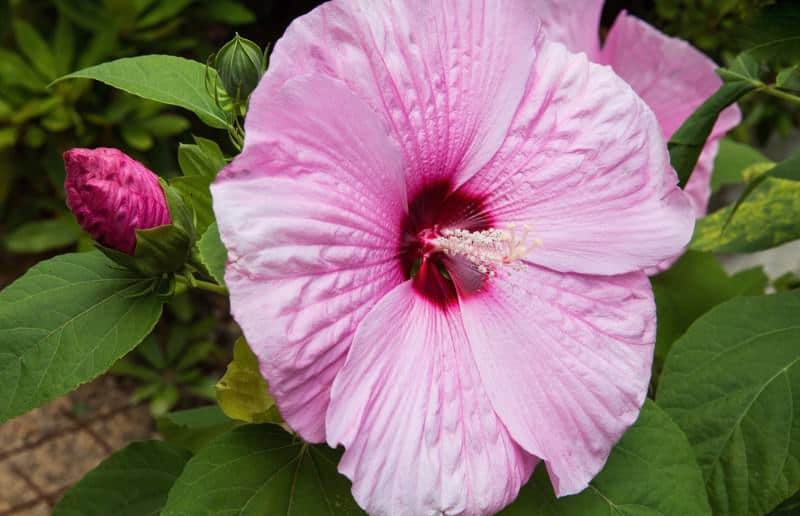
- Common Name: Scarlet rose mallow
- Scientific Name: Hibiscus coccineus
- Type: Perennial
- Water: Medium to wet
- Soil PH: 6.5 to. 6.8
- Flower Color: Deep red
- Special Characteristics: Attracts hummingbirds and butterflies, deer-resistant, showy flowers
- Hardiness Zone(s): 6 to 9
- Height At Maturity: 36-72″
- Sun: Full sun to part shade
- Sub Type: Groundcover
Scotts Clematis
The Scotts Clematis flower is a stunning wildflower plant that blooms very early. It is an attractive, hardy perennial with lovely, long-lasting blue bell-shaped flowers.
Scotts Clematis flowers are low-maintenance and require very little care to flourish.
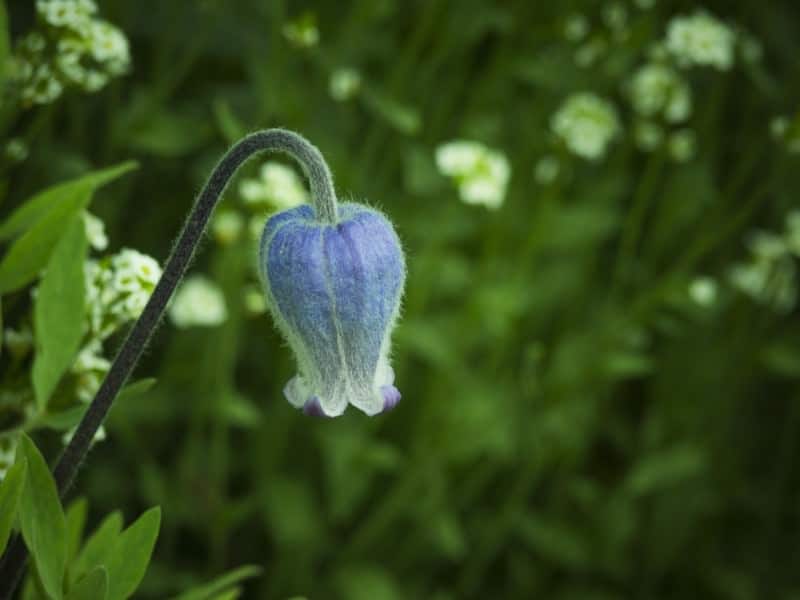
- Common Name: Scotts clematis
- Scientific Name: Clematis scottii
- Type: Perennial
- Water: Medium
- Soil PH: 7-8
- Flower Color: Deep blue
- Special Characteristics: Tolerates rabbit, deer-resistant, showy flowers
- Hardiness Zone(s): 4 to 7
- Height At Maturity: 9-12″
- Sun: Full sun to part shade
- Sub Type: Groundcover
Serbian Bellflower
Serbian bellflowers are easy to grow and maintain.
The flowers are a lavender-blue color.
They are 1-inch in diameter and star-shaped. The foliage remains evergreen in mild winters.
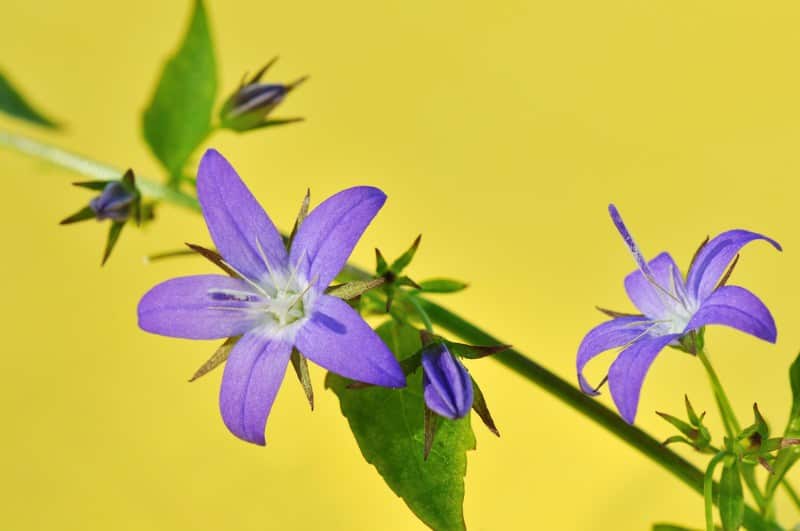
- Common Name: Serbian bellflower
- Scientific Name: Campanula poscharskyana “Stella”
- Type: Perennial
- Water: Medium
- Soil PH: 6-8
- Flower Color: Deep blue
- Special Characteristics: Deer-resistant, showy flowers, easy to grow
- Hardiness Zone(s): 3 to 8
- Height At Maturity: 3-6″
- Sun: Full sun to part shade
- Sub Type: Groundcover
Seven Stars
Seven Stars cactus cacti are a rare species of cacti. They are slow-growing and small, usually growing to be about 9-10 inches in diameter.
The plant is best recognized for its grey to pale brown colored flowers.
They grow best when potted by themselves.
Most of the plant is beneath the surface of the soil.
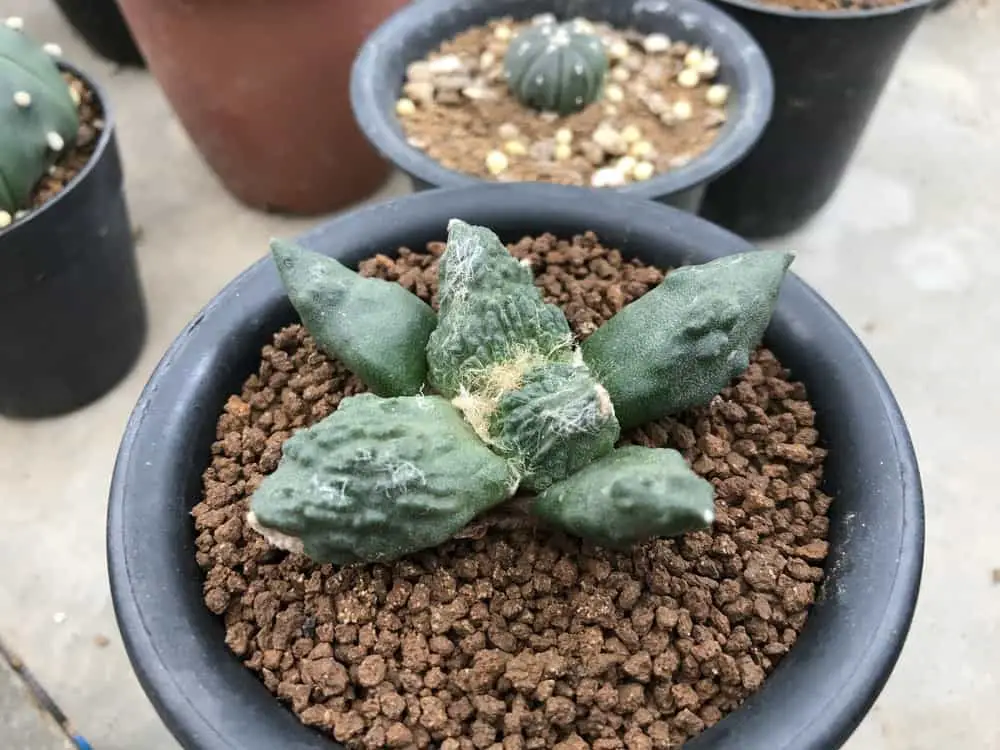
- Common Name: Seven Stars
- Scientific Name: Ariocarpus furfuraceus
- Type: Cactus/Succulent
- Water: Dry
- Soil PH: 6.1-7.8
- Flower Color: Pink, yellow
- Special Characteristics: Container, showy flowers
- Hardiness Zone(s): 10-11
- Height At Maturity: 1-6″
- Sun: Full Sun, Partial Sun
- Sub Type: Houseplant
Shining Blue Star
Shining Blue Starflower is a perennial plant that originates from North America.
Shining Blue Starflower is a kind of herbaceous plant and has a particular shape with a cylindrical, spiky leaves.
This flower grows on a single stem and has beautiful bright blue flowers.
The flowers are known to attract several species of butterfly.
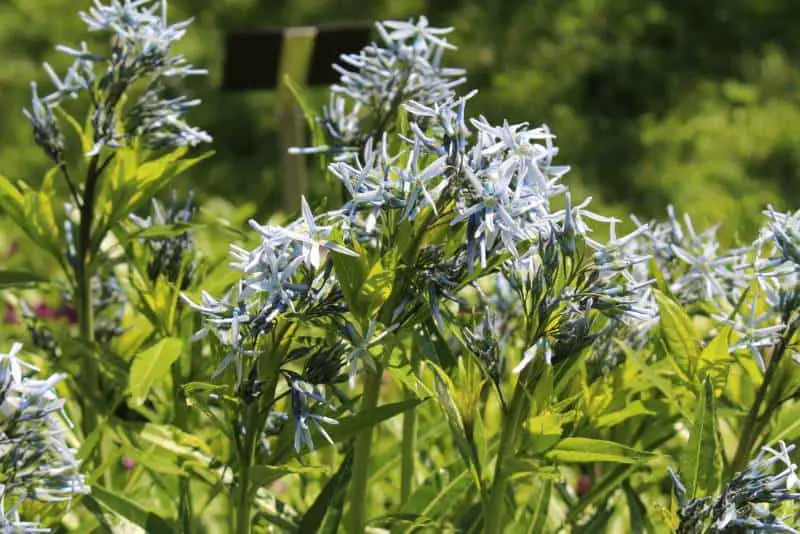
- Common Name: Shining blue star
- Scientific Name: Amsonia illustris
- Type: Perennial
- Water: Medium
- Soil PH: 6.8-7.2
- Flower Color: Light blue
- Special Characteristics: Attracts butterflies, deer-resistant, showy flowers, easy-to-grow
- Hardiness Zone(s): 5 to 9
- Height At Maturity: 24-36″
- Sun: Full sun to part shade
- Sub Type: Groundcover
Showy Stonecrop
Showy stonecrop, also known as Sedum spectabile, is a flowering plant that originally comes from China.
Showy stonecrop mostly exhibits pink flowers and grows as a perennial ground cover. However, it does come in a wide variety of heights, colors, and forms.
Showy stonecrop has been cultivated throughout the world as an ornamental plant because of its beauty and ease of care.
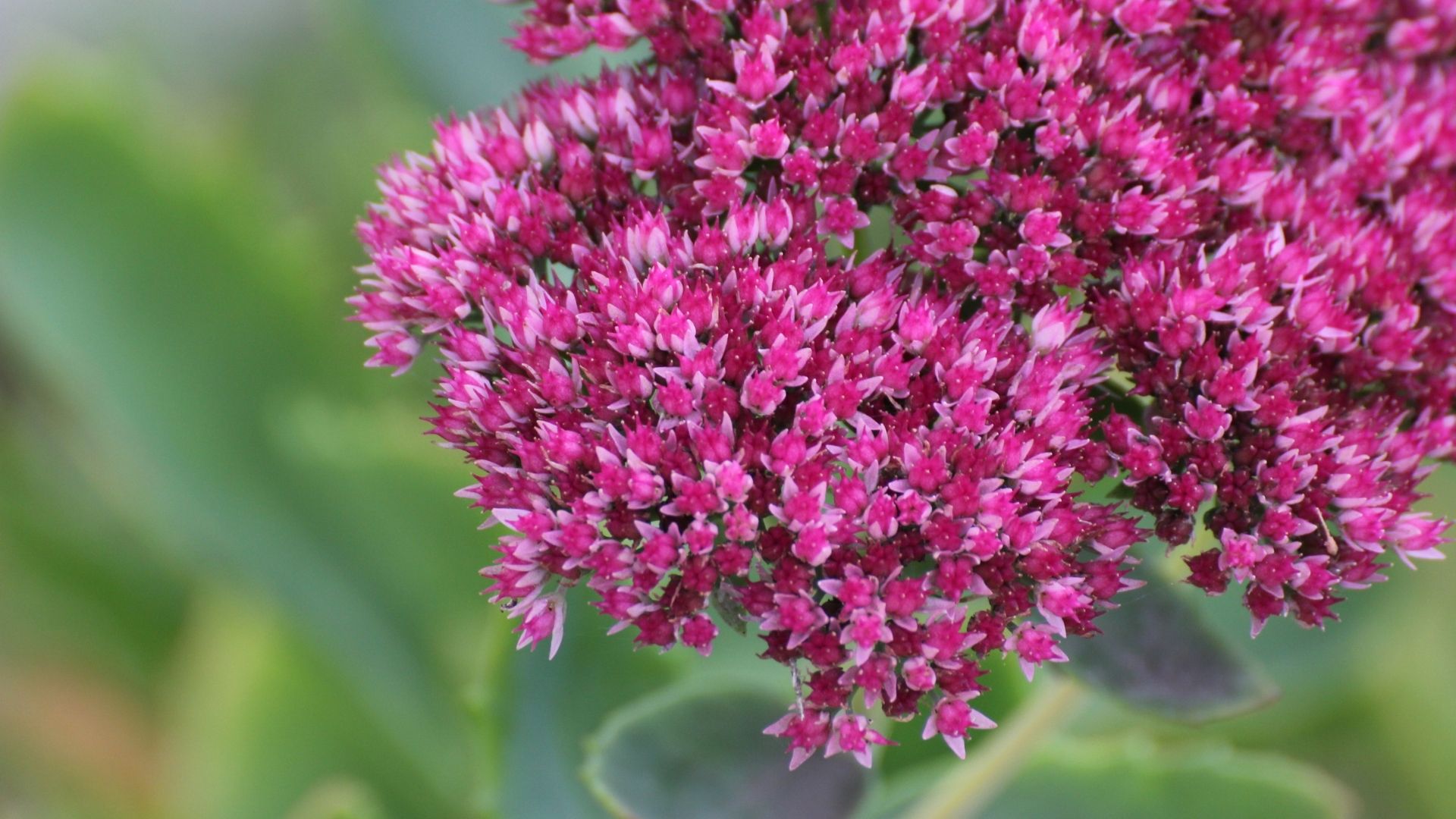
- Common Name: Showy stonecrop
- Scientific Name: Sedum spectabile
- Type: Perennial
- Water: Dry to medium
- Soil PH: 6.1-7.8
- Flower Color: Deep rose
- Special Characteristics: Attracts birds and butterflies, Container
- Hardiness Zone(s): 3 to 9
- Height At Maturity: 12″-18″
- Sun: Full Sun
- Sub Type: Groundcover
Siberian Bugloss
Blue flowers with a heart-shaped form and delicate stems are beheld from low-lying cushions of slim, heart-shaped, rough-textured green foliage.
They have deeper hues than the Forget-me-Nots, but they bloom less frequently. They prefer dappled shade and are frost-hardy woodland plants.

- Common Name: Siberian bugloss
- Scientific Name: Brunnera macrophylla
- Type: Perennial
- Water: Needs moderate moisture
- Soil PH: 5.8 to 6.3
- Flower Color: Intense blue
- Special Characteristics: Tolerates rabbit, showy flowers, easy-to-grow
- Hardiness Zone(s): 3 to 8
- Height At Maturity: 12-18”
- Sun: Part shade
- Sub Type: Groundcover
Siberian Iris
Siberian irises prefer soil that has some humus (organic material that forms in soil when plant and animal matter decays) added.
To promote growth, add some compost, decomposed manure, or leaf mold.
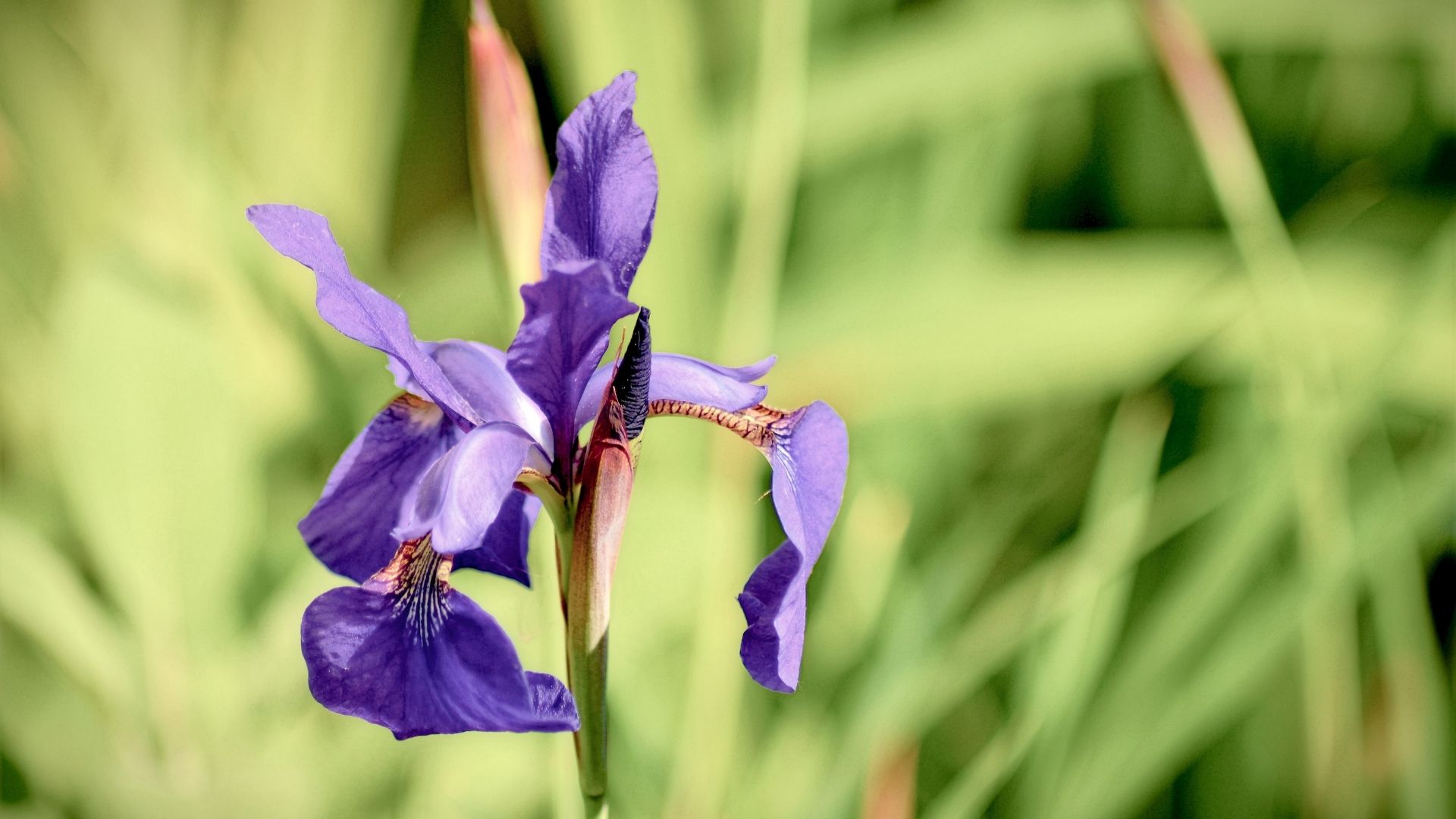
- Common Name: Siberian Iris
- Scientific Name: Iris Sibirica
- Type: Perennial
- Water: Medium to wet
- Soil PH: 5.5 to 6.9
- Flower Color: Deep purple
- Special Characteristics: Attracts birds and butterflies, Cut flowers
- Hardiness Zone(s): 3 to 8
- Height At Maturity: 36″-48″
- Sun: Full Sun
- Sub Type: Groundcover
Siberian Larkspur
Native to Russia and China, it is also known as Delphinium grandiflorum or Chinese Delphinium.
Although Siberian Larkspur looks like a delicate flower, this plant is actually one of the most dangerous flowers you can have in your garden.
It is a short-lived perennial that, in many circumstances, is recommended to be treated as an annual owing to its unpredictability in terms of coming back the next season.
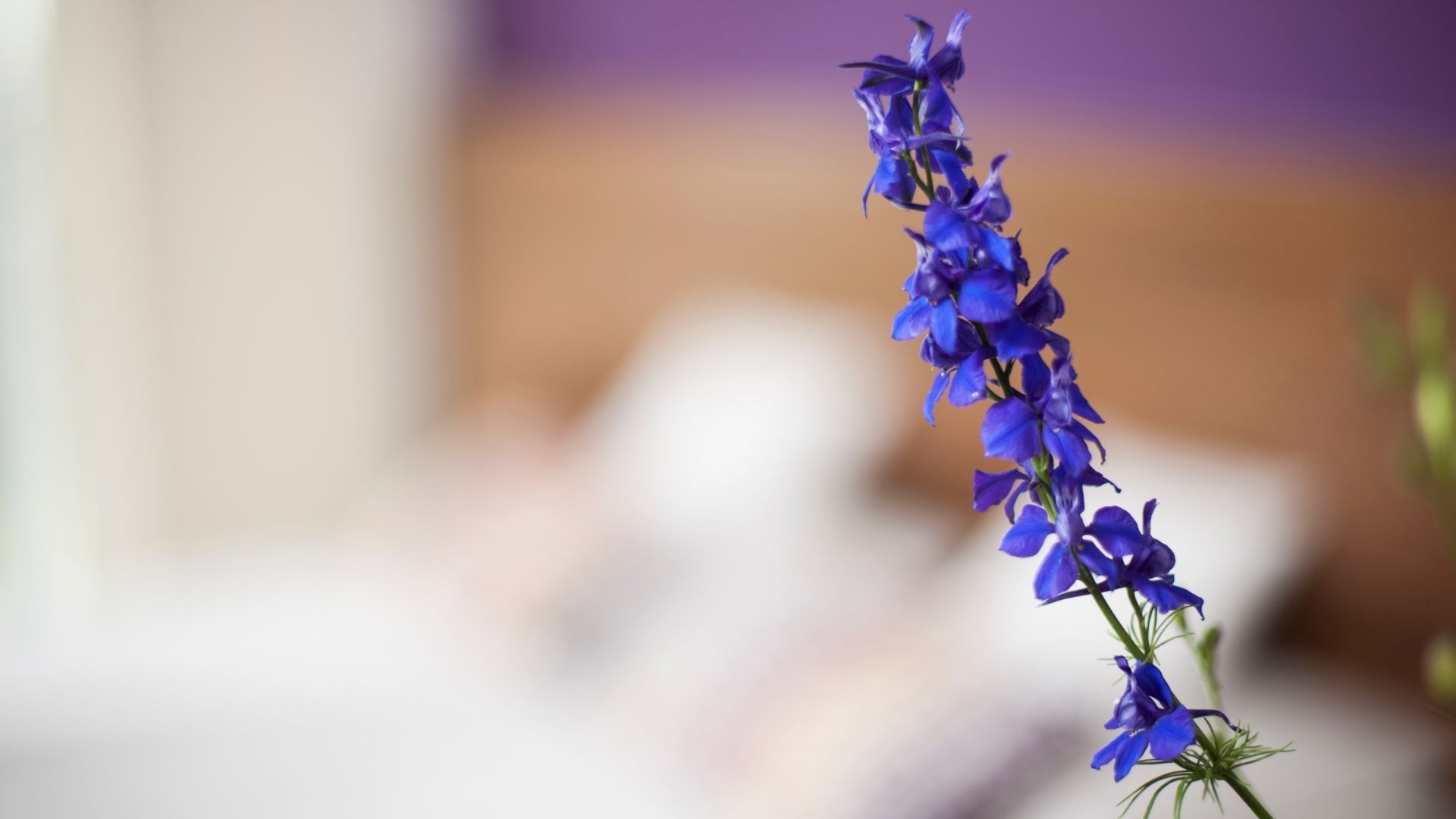
- Common Name: Siberian larkspur
- Scientific Name: Delphinium grandiflorum
- Type: Perennial
- Water: Needs moderate moisture
- Soil PH: 6-8
- Flower Color: Blue
- Special Characteristics: Attracts butterflies, deer-resistant, showy flowers, easy-to-grow
- Hardiness Zone(s): 4 to 7
- Height At Maturity: 12-24″
- Sun: Full sun
- Sub Type: Groundcover
Snowball Cactus
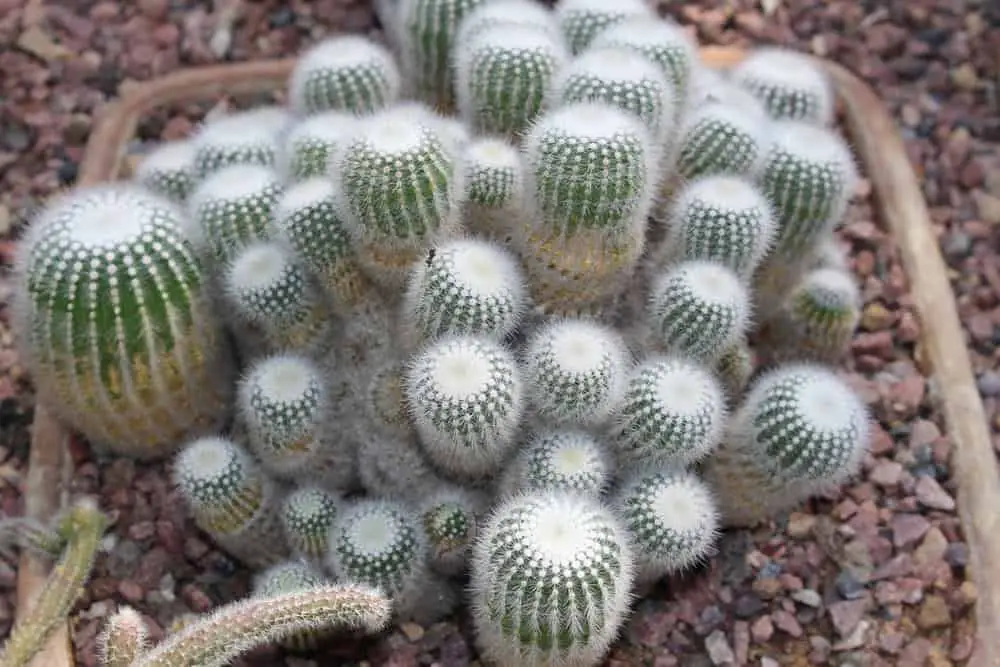
- Common Name: Snowball Cactus
- Scientific Name: Parodia Scopa
- Type: Cactus/Succulent
- Water: Dry to Medium
- Soil PH: 6.1 to 78
- Flower Color: Yellow
- Special Characteristics: Container, Tolerates Drought
- Hardiness Zone(s): 9 to 11
- Height At Maturity: 6″ to 24″
- Sun: Full Sun to Part Shade
Society Garlic
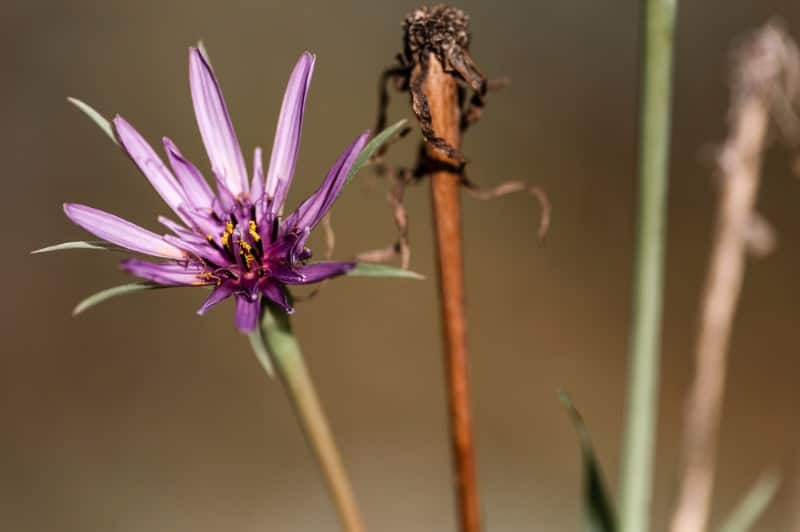
- Common Name: Society garlic
- Scientific Name: Tulbaghia violacea
- Type: Perennial
- Water: Medium
- Soil PH: 5.6 – 7.5
- Flower Color: Lilac-pink
- Special Characteristics: Fragrant, showy flowers, easy-to-grow
- Hardiness Zone(s): 7 to 10
- Height At Maturity: 6-12″
- Sun: Full sun
- Sub Type: Herb
Southern Blue Flag
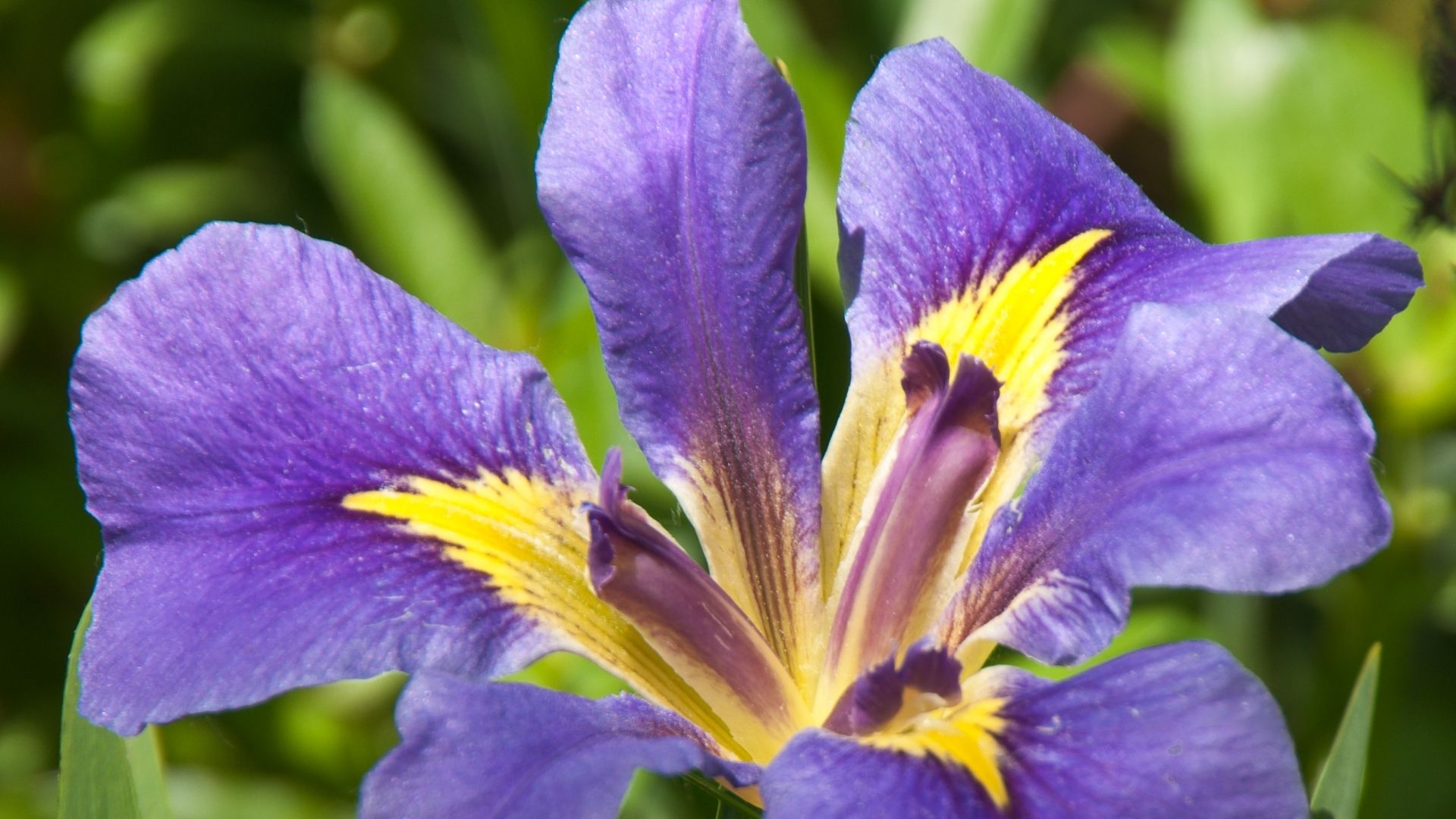
- Common Name: Southern blue flag
- Scientific Name: Iris virginica
- Type: Perennial
- Water: Medium to wet
- Soil PH: 5.5 to 7.5
- Flower Color: Violet blue with yellow and white crested falls
- Special Characteristics: Deer-resistant, showy flowers, easy-to-grow
- Hardiness Zone(s): 5 to 9
- Height At Maturity: 12-36′
- Sun: Full sun
- Sub Type: Groundcover
Spider Flower
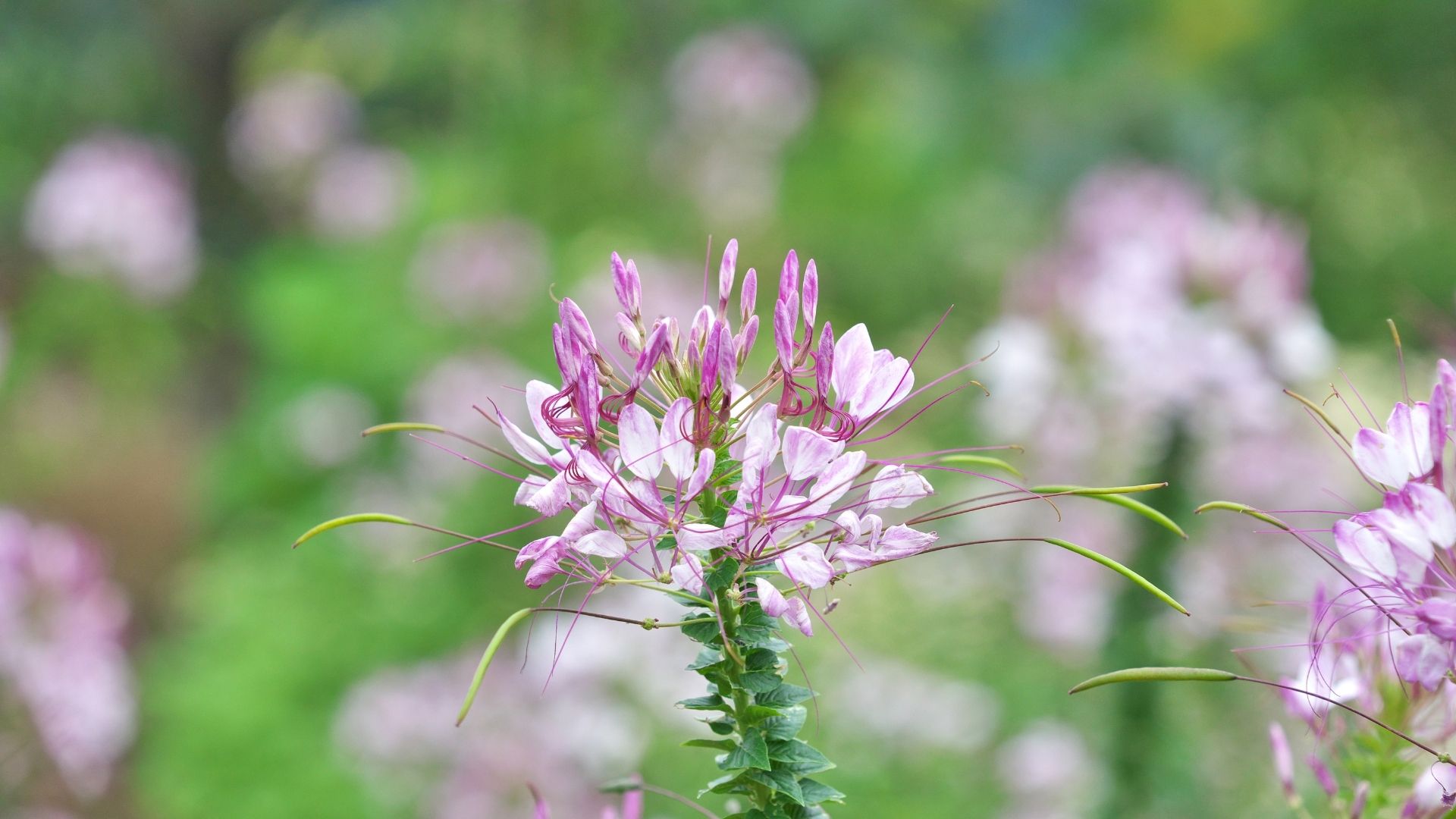
- Common Name: Spider flower
- Scientific Name: Cleome hassleriana
- Type: Annual
- Water: Moderate moisture can tolerate slight drought
- Soil PH: 6.0 to 7.0
- Flower Color: Pink and White (also bicolor)
- Special Characteristics: Attracts birds and butterflies / Fall color
- Hardiness Zone(s): 2 to 11
- Sun: Plenty of Sun
Spider Lily
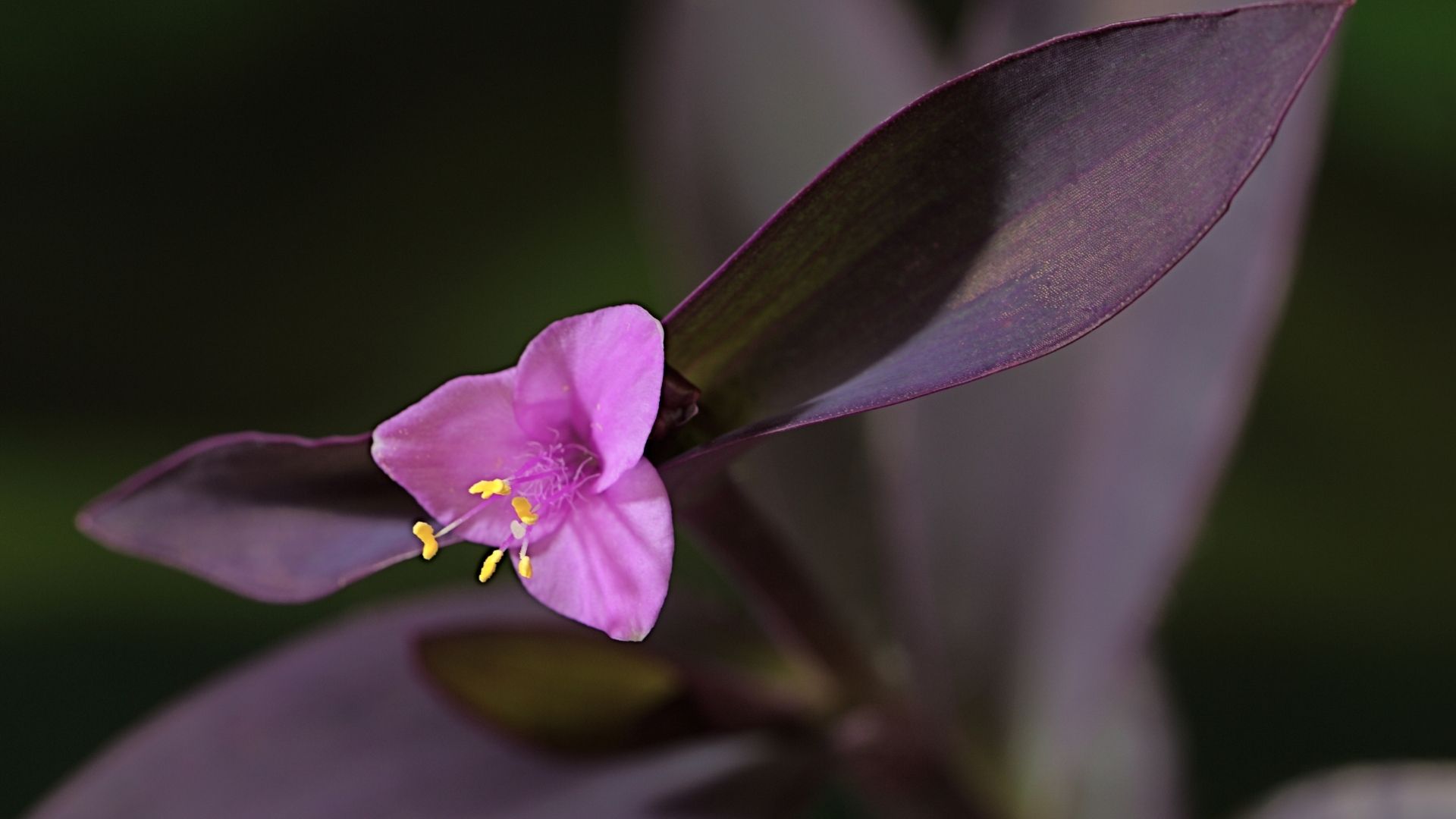
- Common Name: Spider lily
- Scientific Name: Tradescantia pallida “Purpurea”
- Type: Perennial
- Water: Medium
- Soil PH: 5.6-6.0
- Flower Color: Pink
- Special Characteristics: Showy flowers, easy-to-grow
- Hardiness Zone(s): 10 to 11
- Height At Maturity: 3-9′
- Sun: Full sun to part shade
- Sub Type: Groundcover
Spiked Speedwell
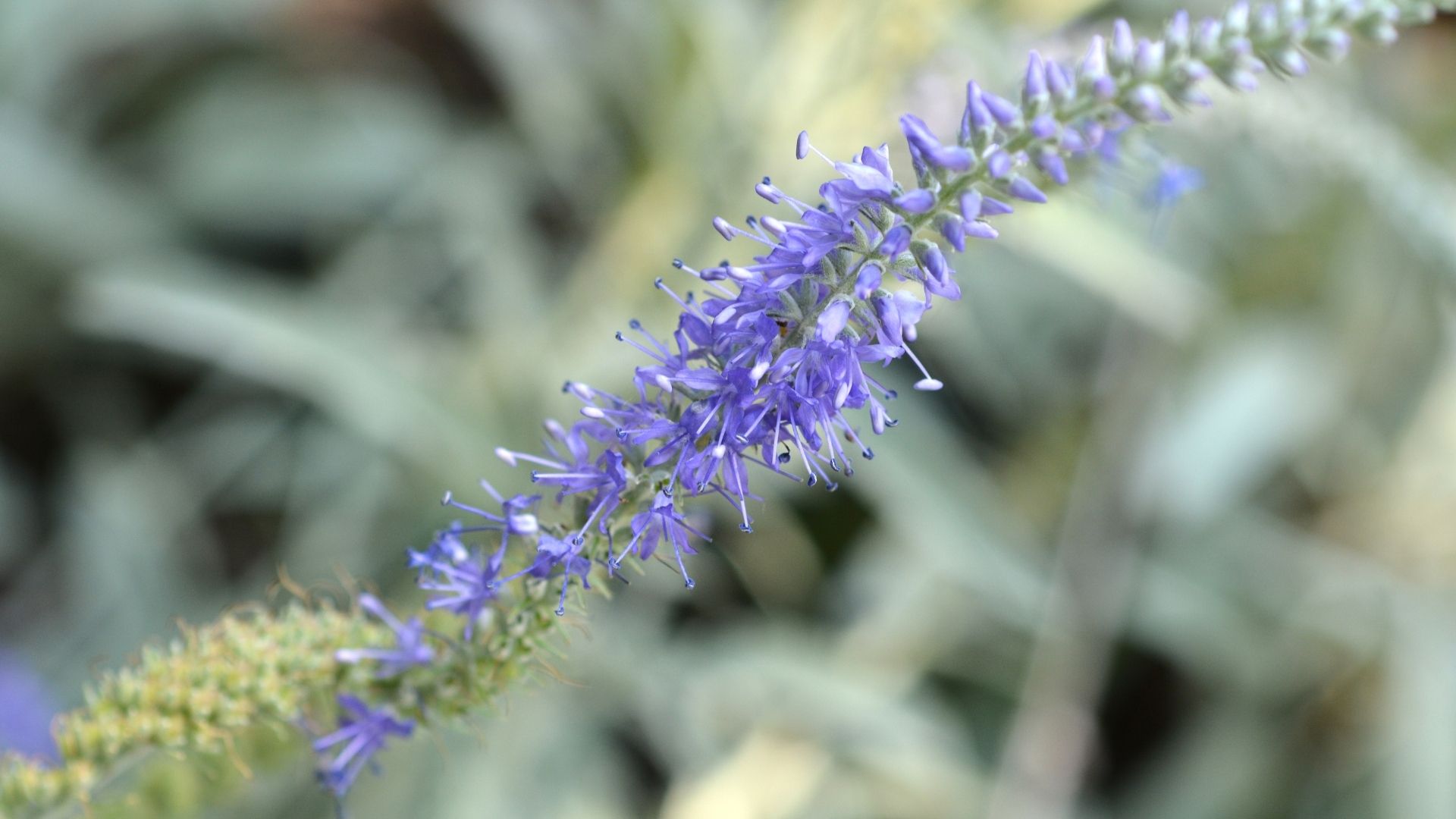
- Common Name: Spiked speedwell
- Scientific Name: Veronica spicata
- Type: Perennial
- Water: Medium
- Soil PH: 5.5-6.2
- Flower Color: Blue
- Special Characteristics: Tolerates rabbit, deer-resistant, showy flowers, easy-to-grow, cut flowers
- Hardiness Zone(s): 3 to 8
- Height At Maturity: 24-30”
- Sun: Full sun
- Sub Type: Groundcover
Spiny Lilac Flower Cactus

- Common Name: Spiny lilac flower cactus
- Scientific Name: Acanthocalycium klimpelianum
- Type: Cactus/Succulent
- Water: Dry
- Soil PH: 6.1-7.8
- Flower Color: Purple, white
- Special Characteristics: Container, showy flowers
- Hardiness Zone(s): 10-11
- Height At Maturity: 1-6″
- Sun: Full Sun, Partial Sun
- Sub Type: Houseplant
St. John’s Wort Plant

- Common Name: St. John’s Wort Plant
- Scientific Name: Hypericum
- Type: Shrub
- Water: Moderate
- Soil PH: 5.5 to 7.0
- Flower Color: Yellow
- Special Characteristics: Attracts birds and butterflies, Showy Flowers
- Hardiness Zone(s): 5 to 8
- Height At Maturity: 36″ to 48″
- Sun: Full Sun
- Sub Type: Deciduous
References
- Flower Glossary – View Names & Images of Flowers | Teleflora – https://www.teleflora.com/floral-facts/glossary-of-flowers
- Most Popular Flowers like Rose, Chrysanthemums, Narcissus and more – The Flower Expert – https://www.theflowerexpert.com/content/mostpopularflowers/more-popular-flowers
More on My Garden Flowers:
